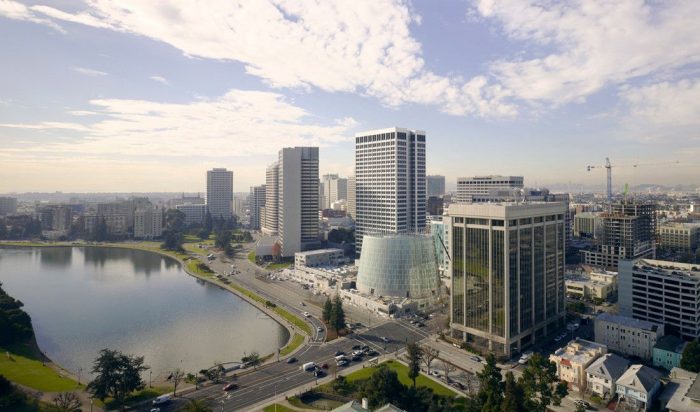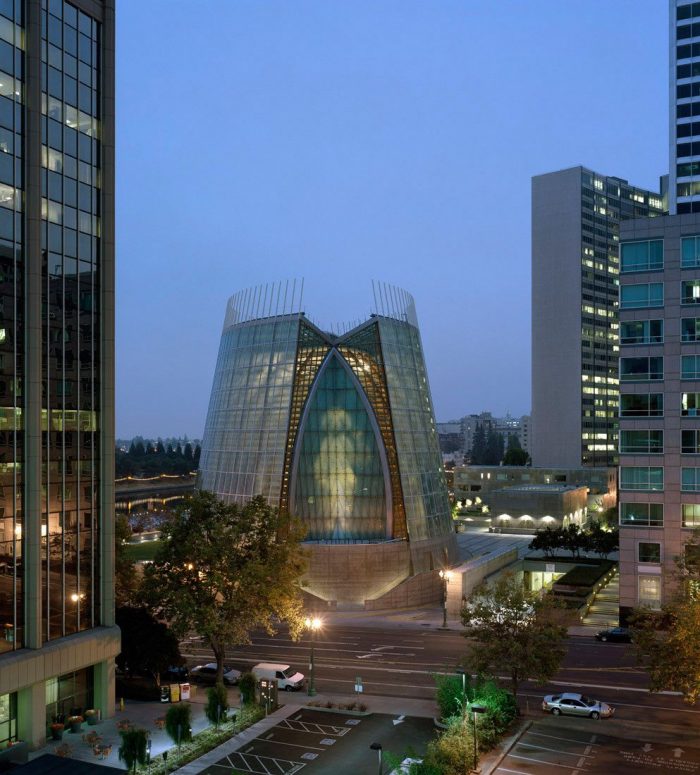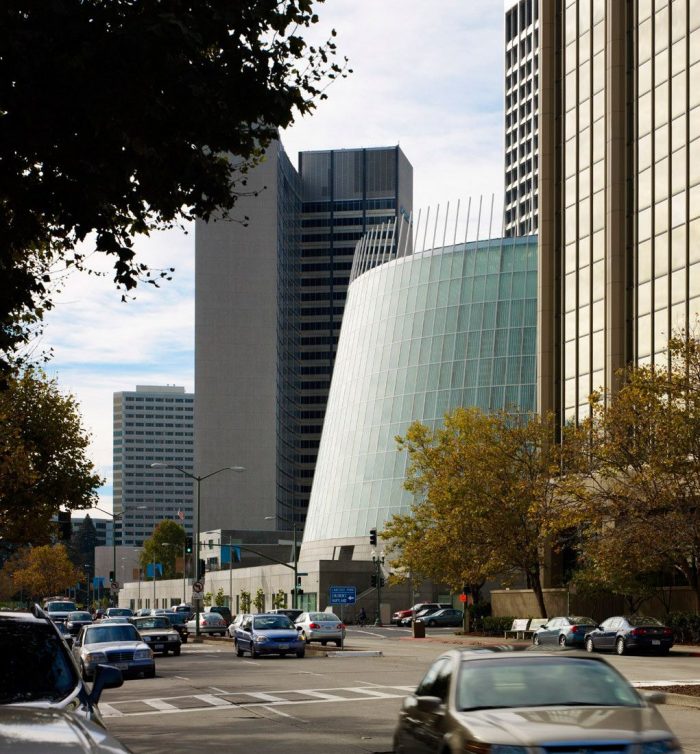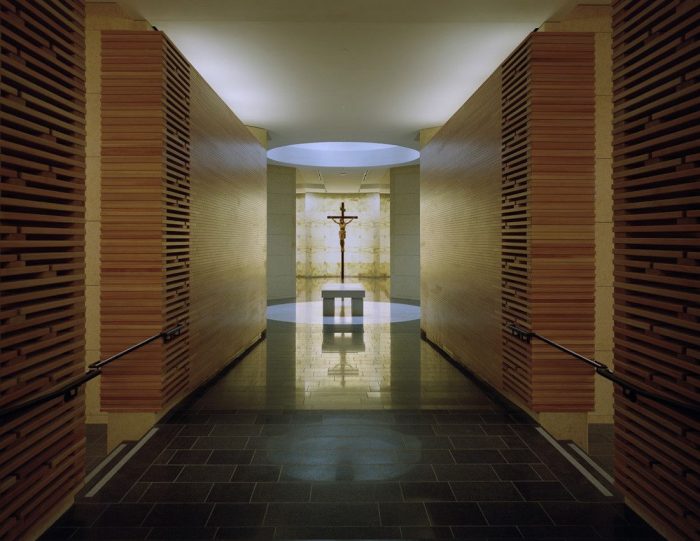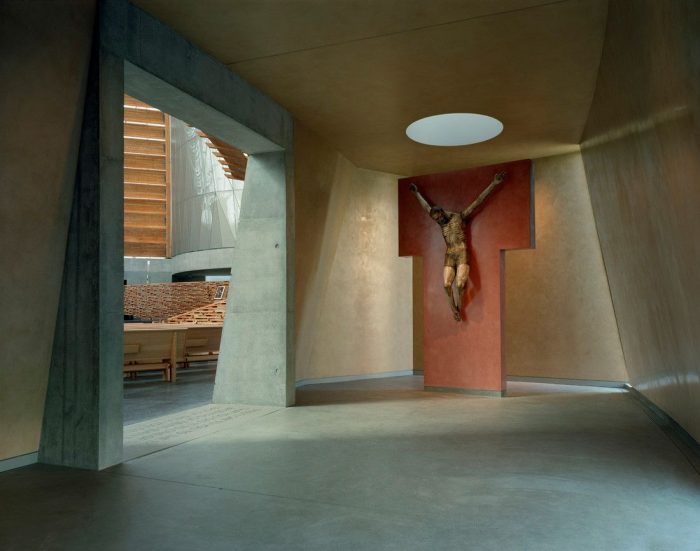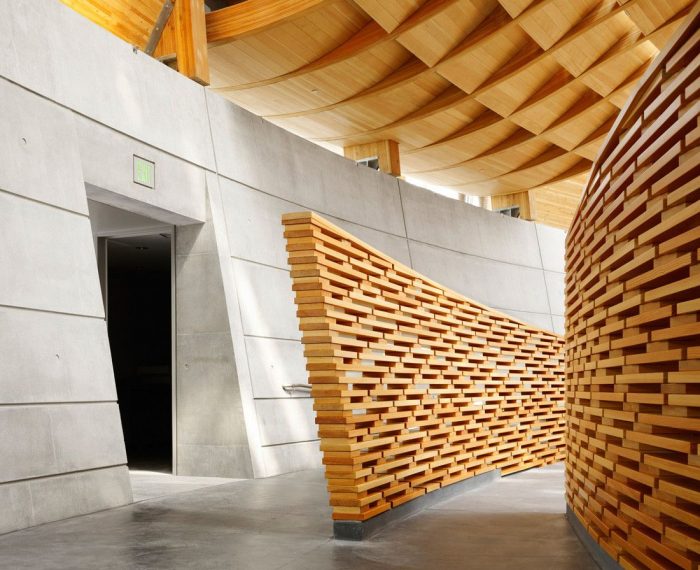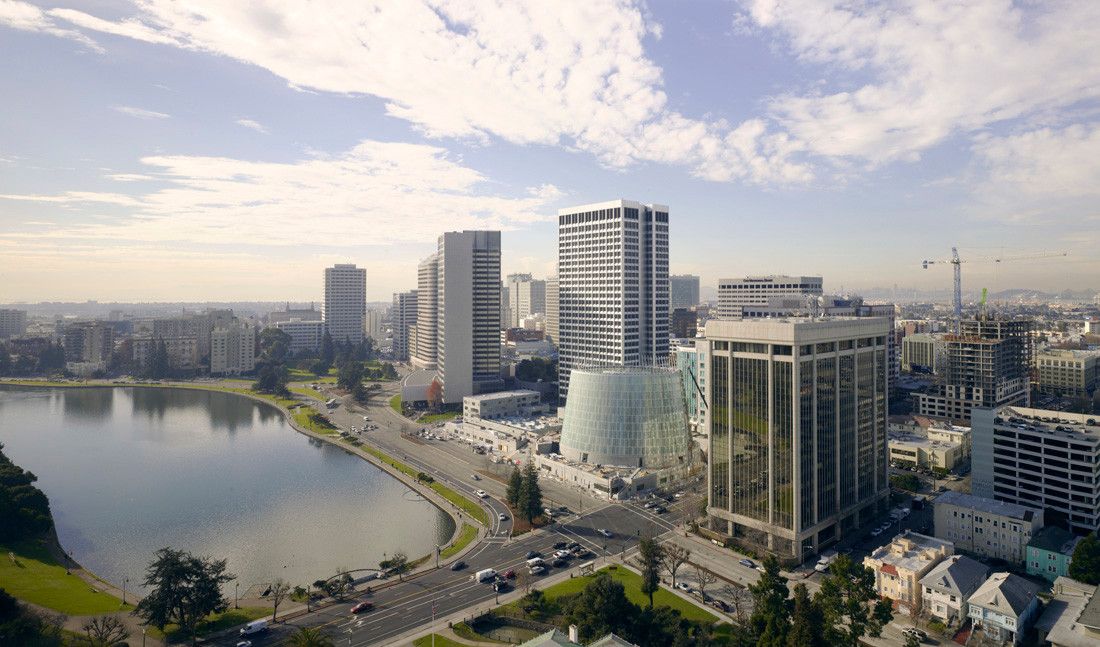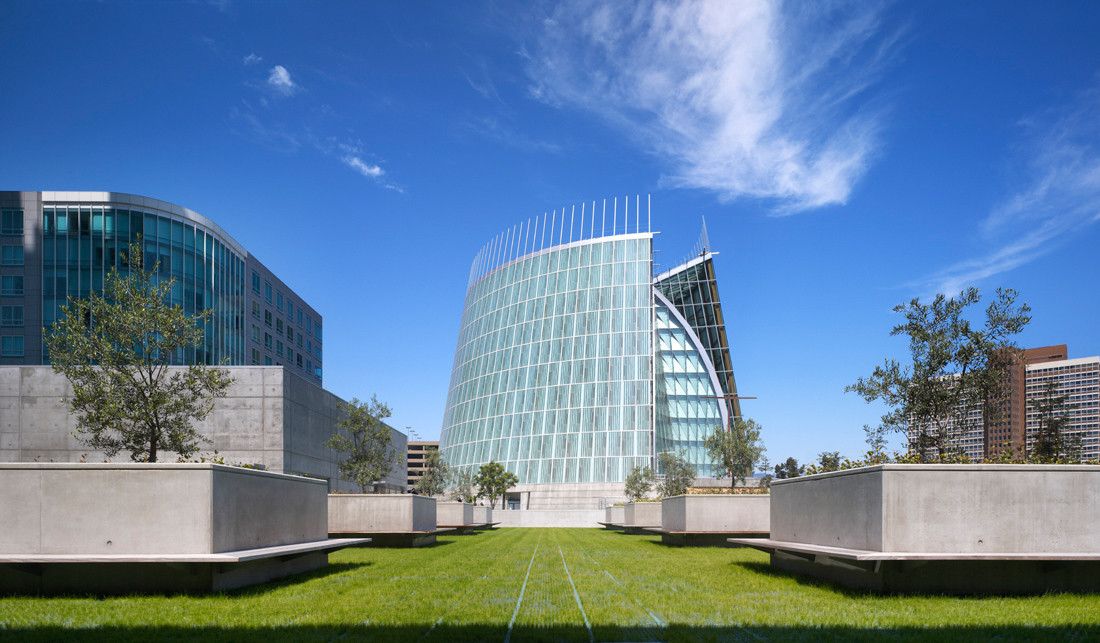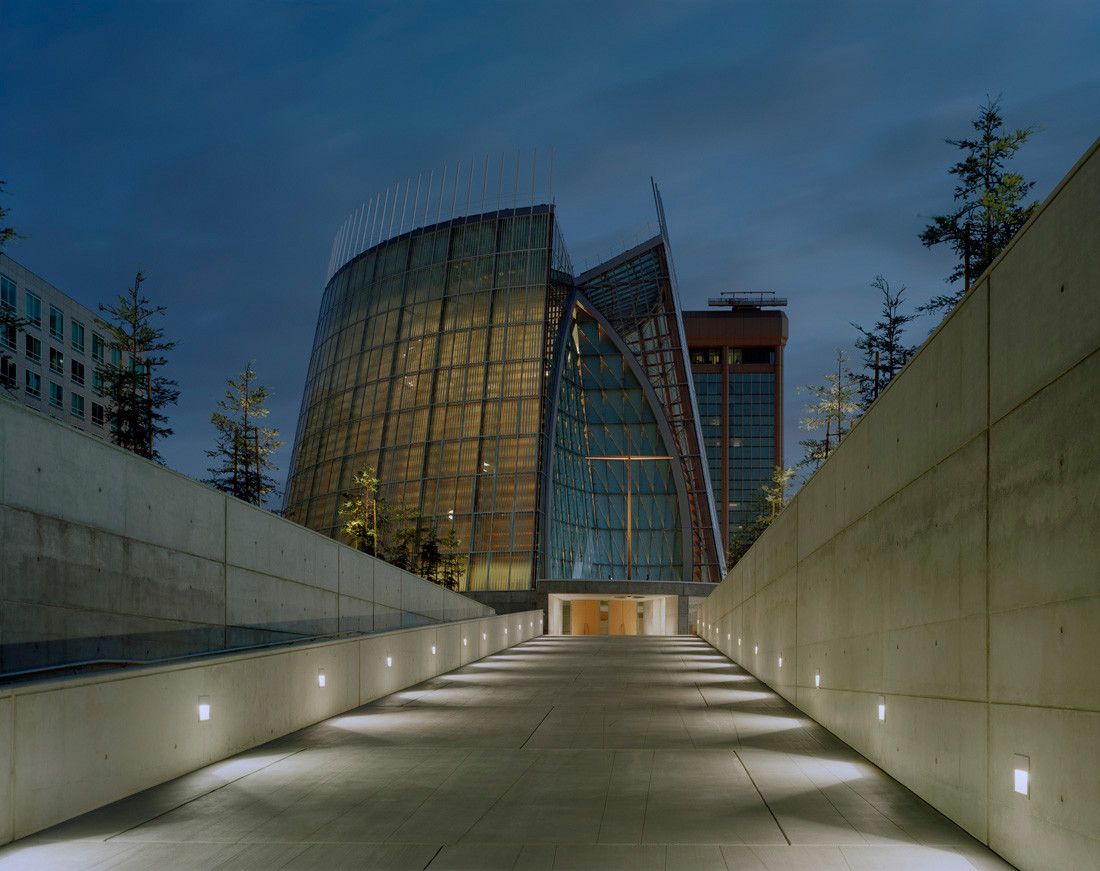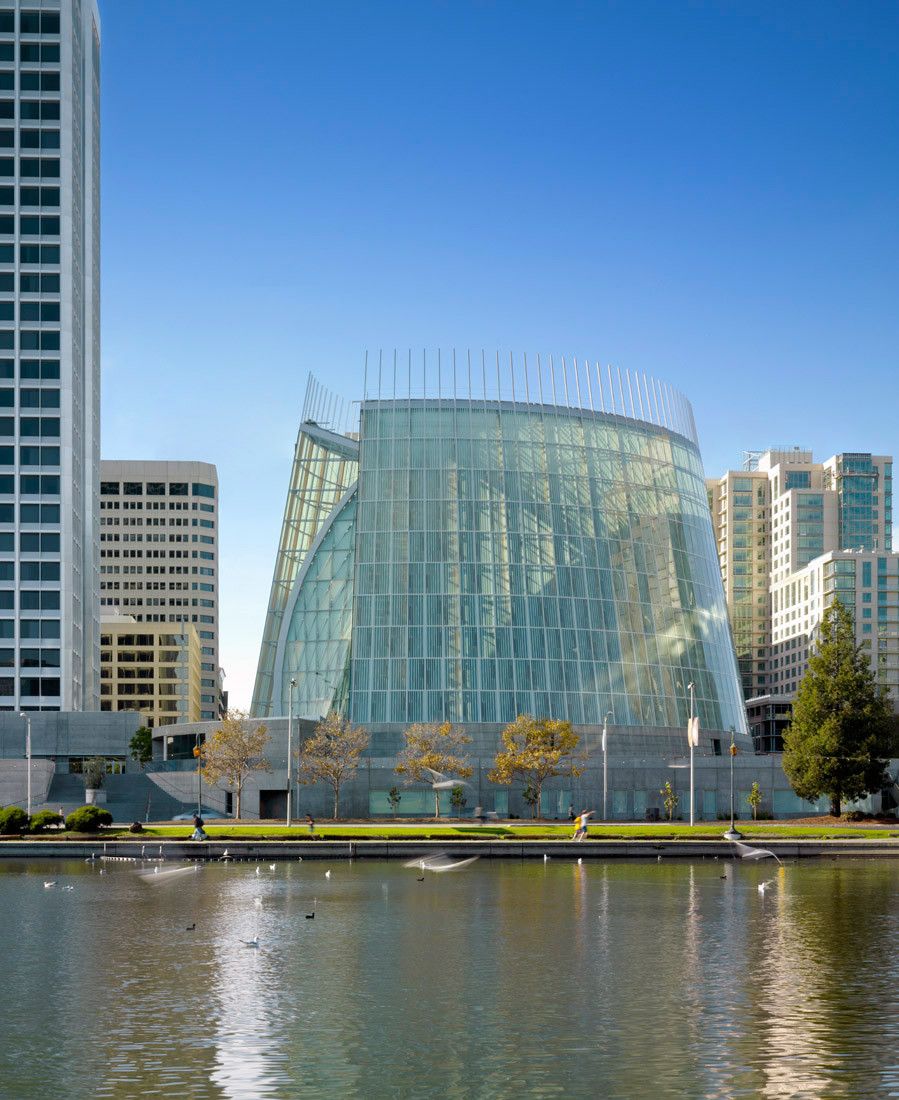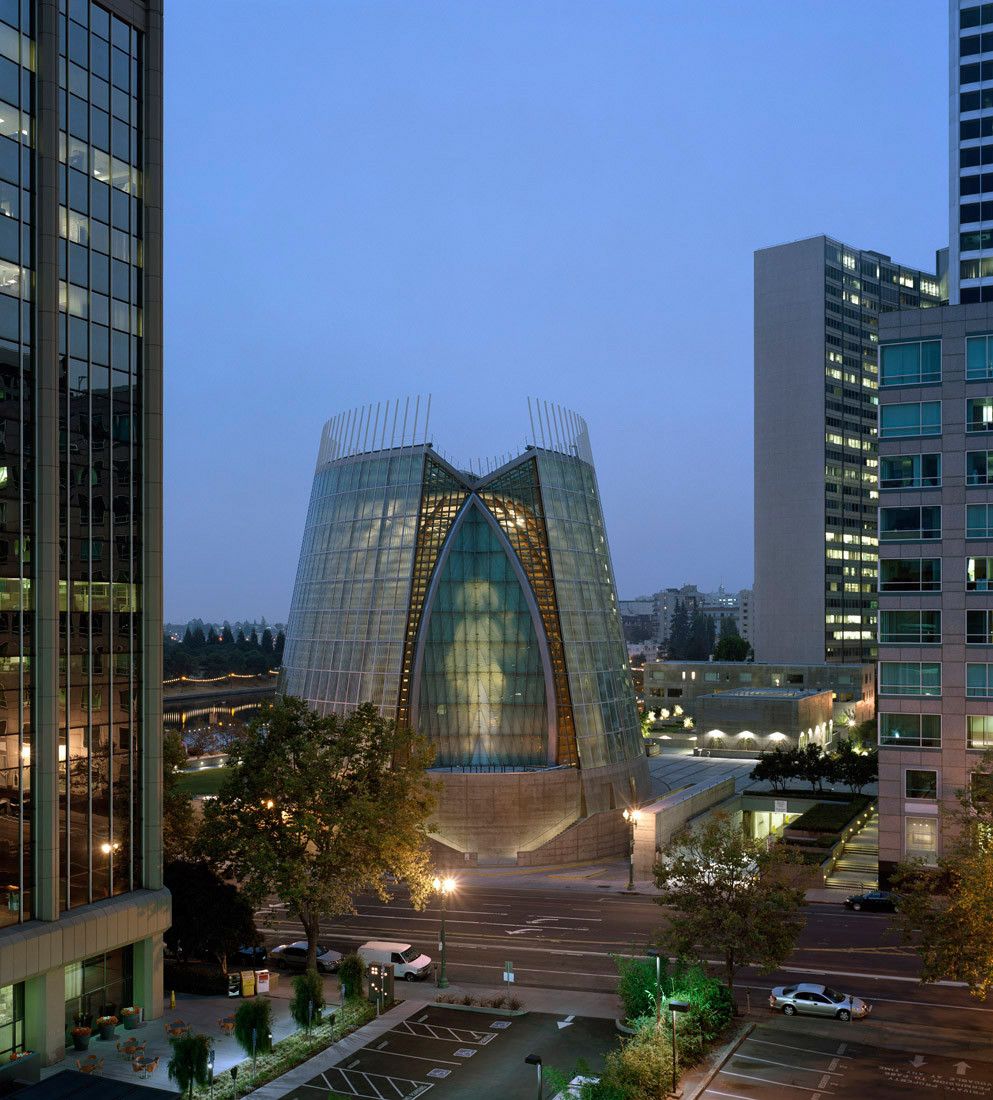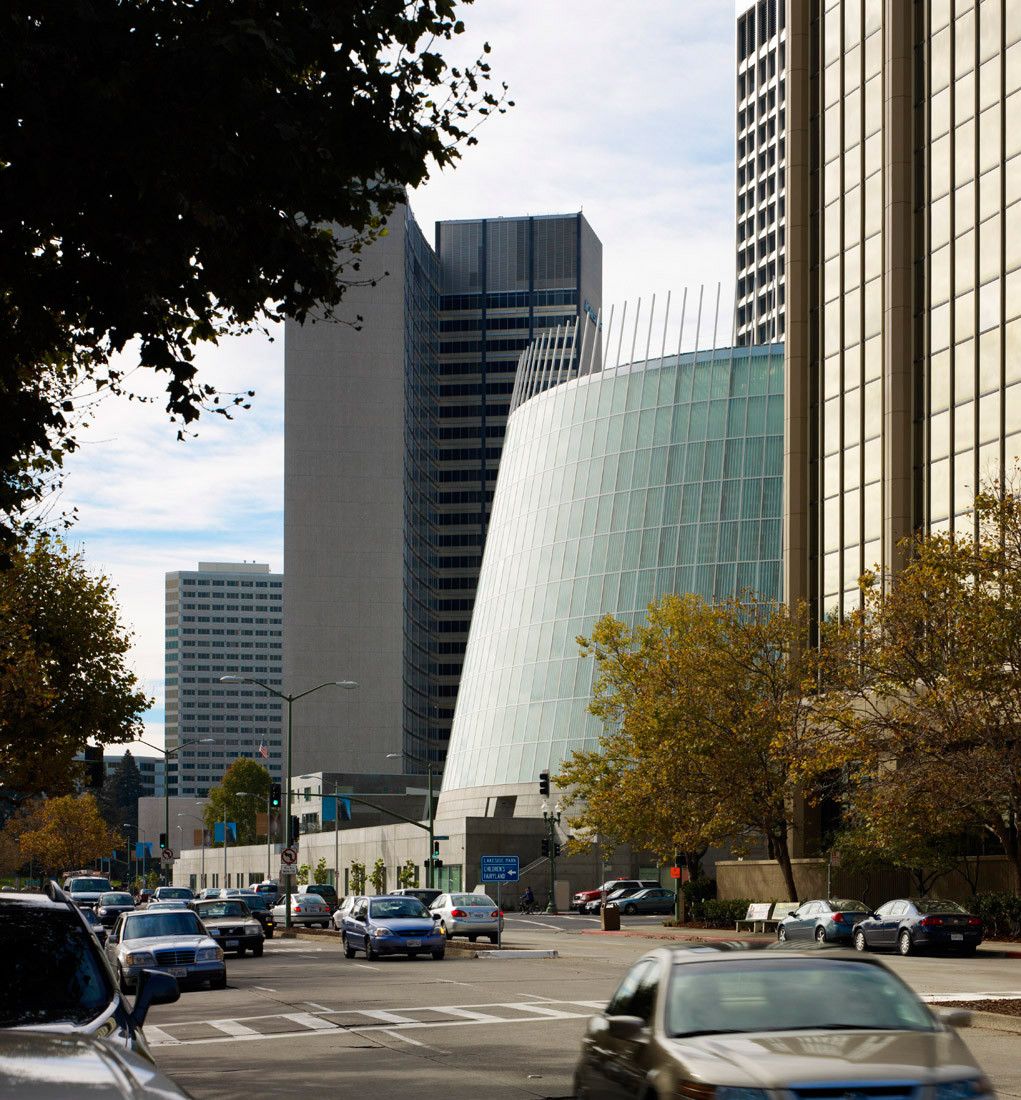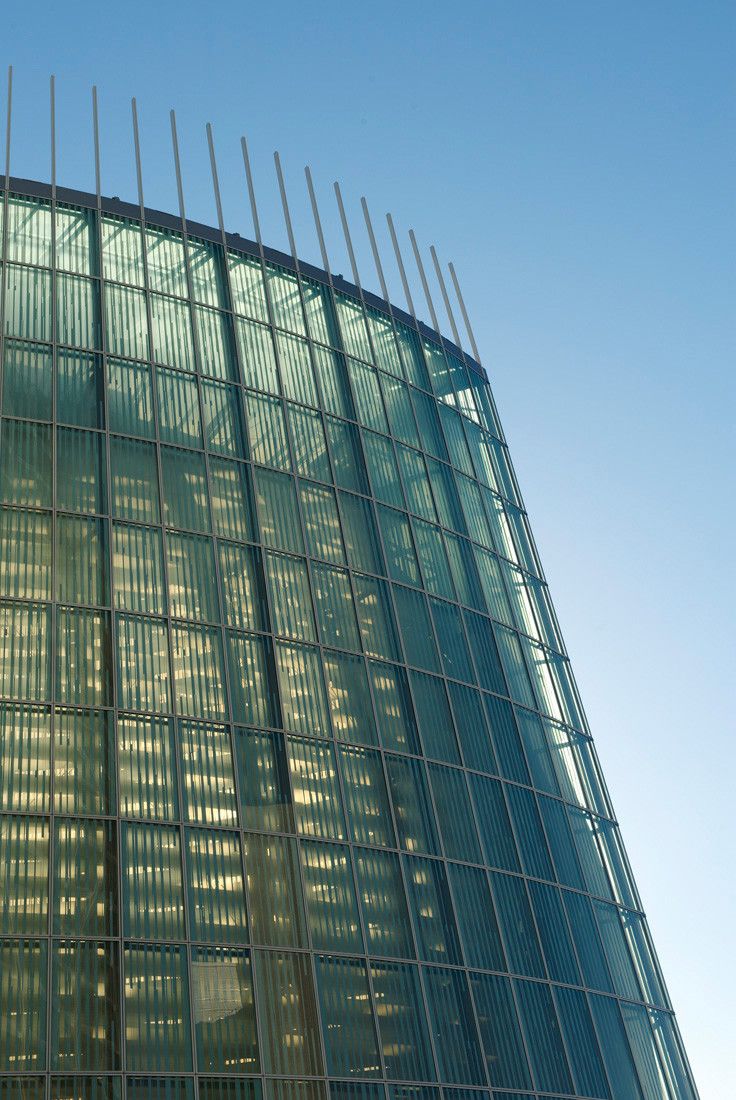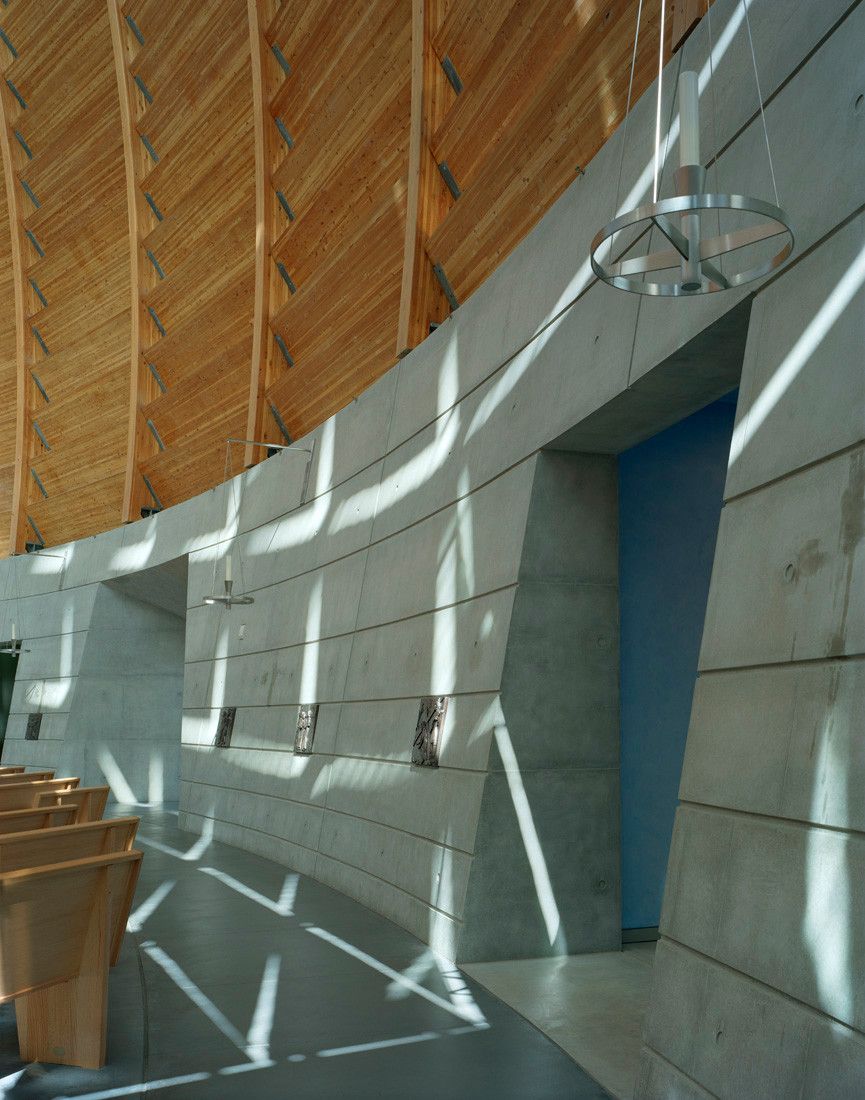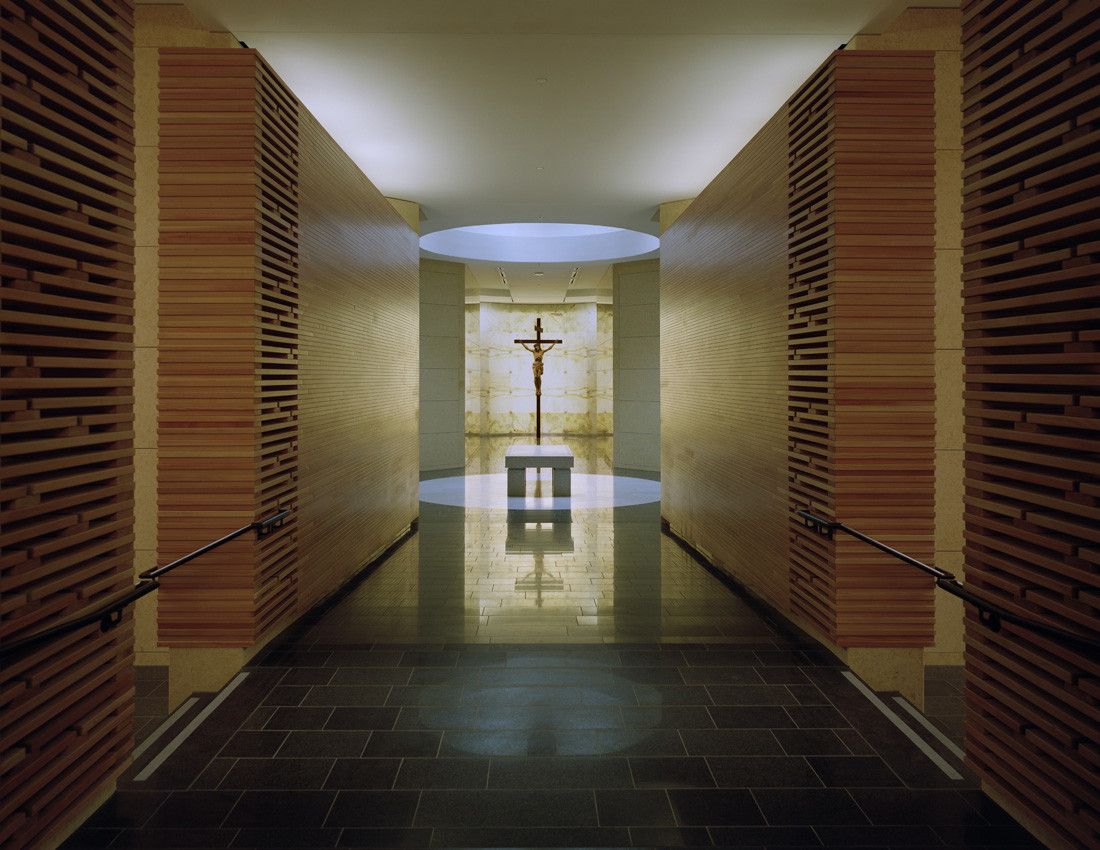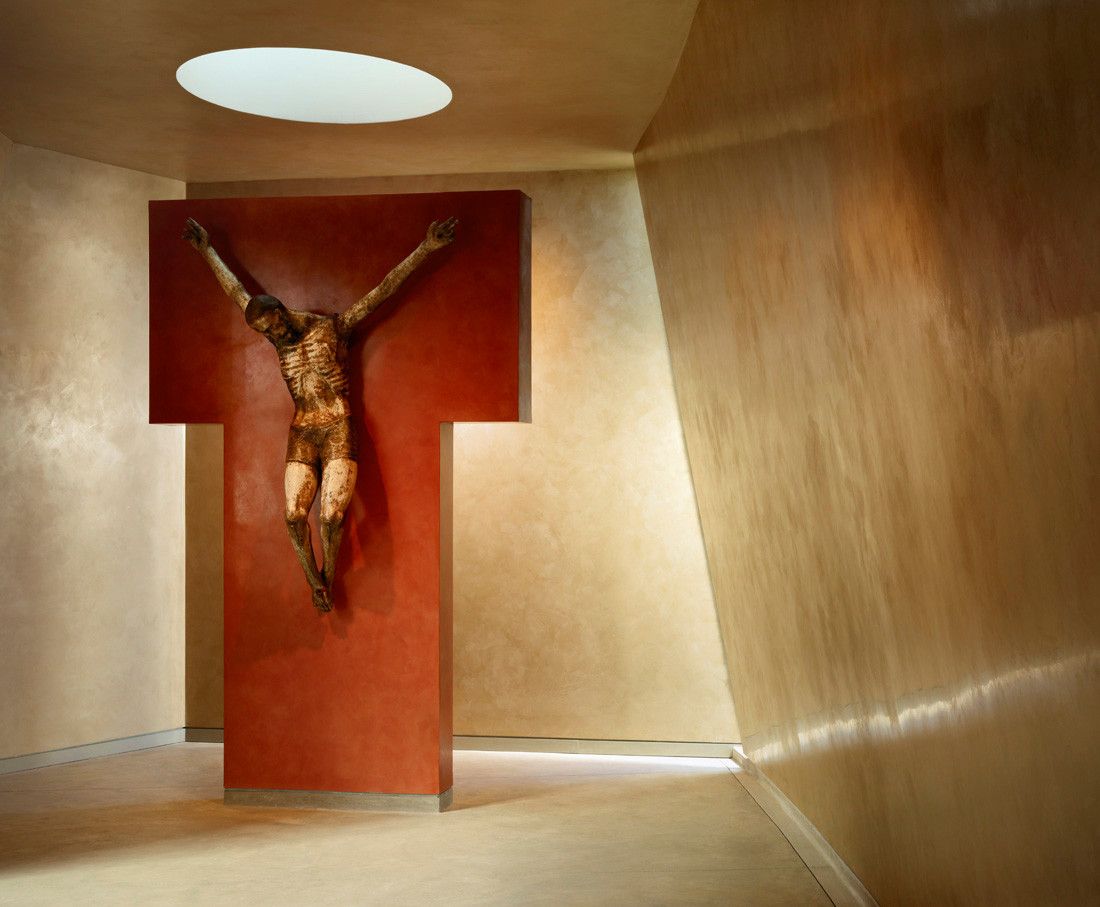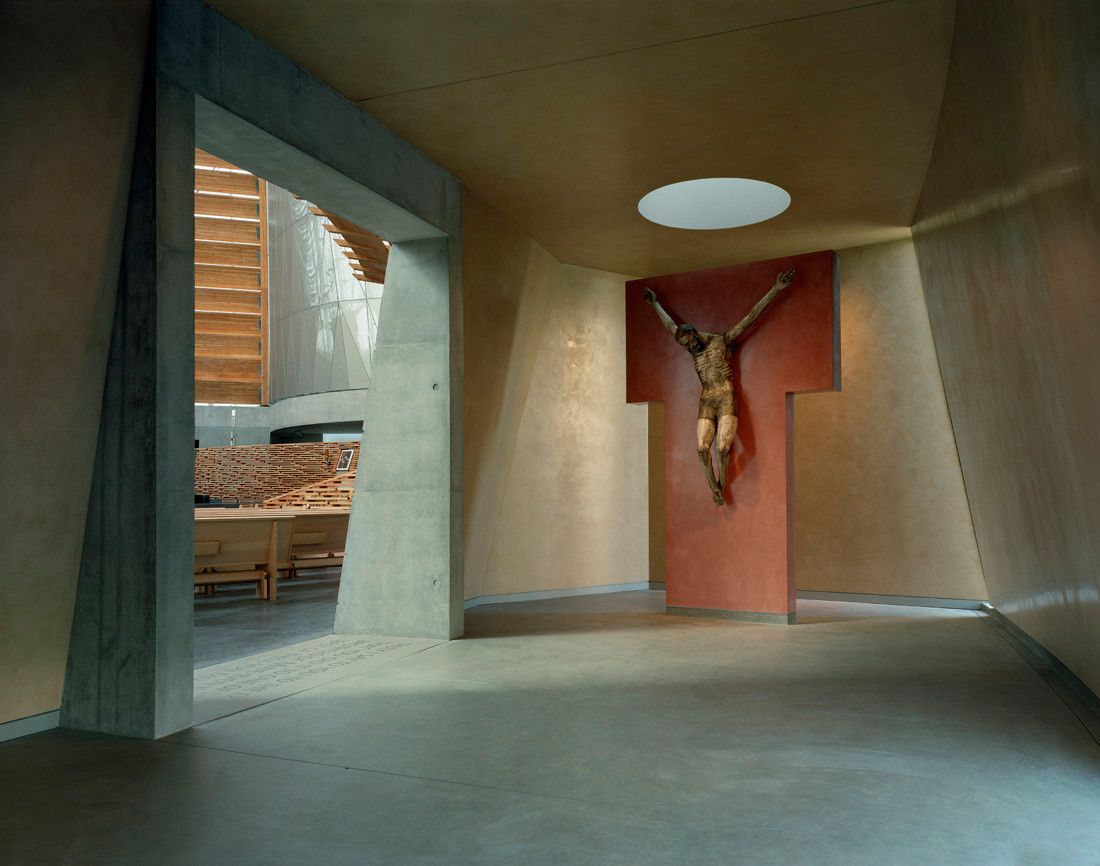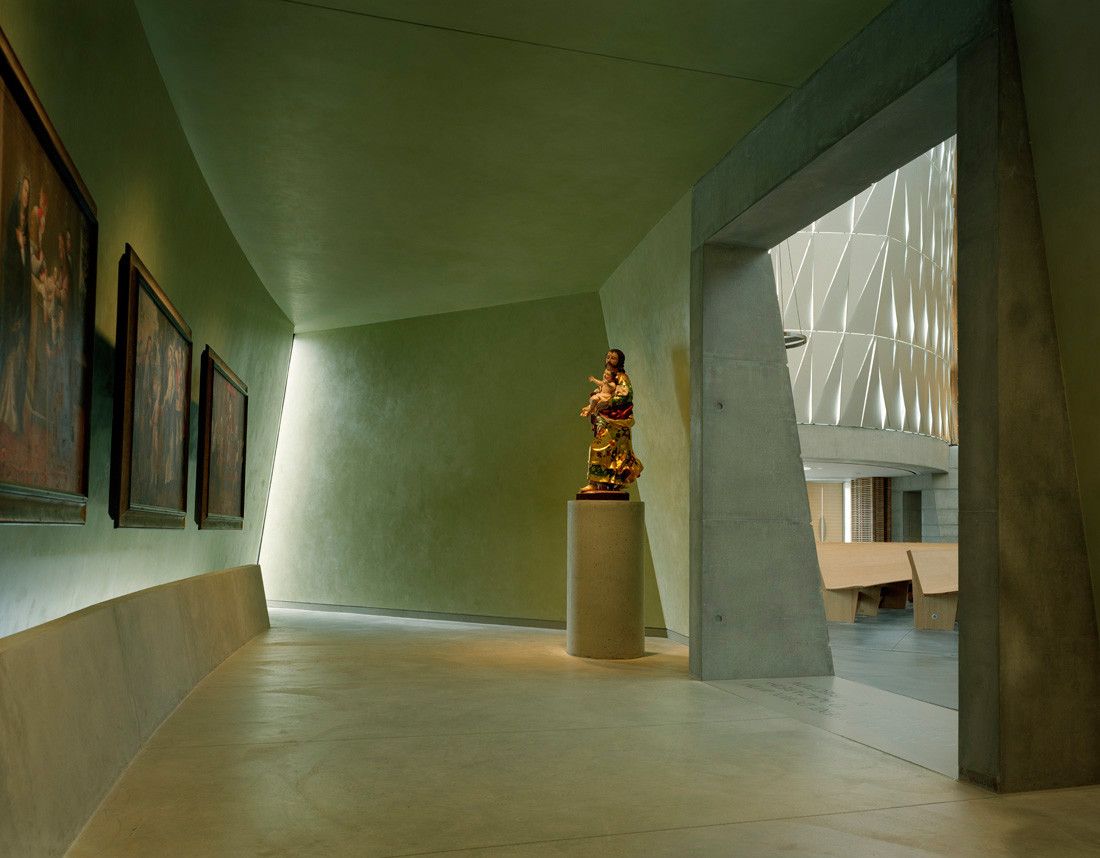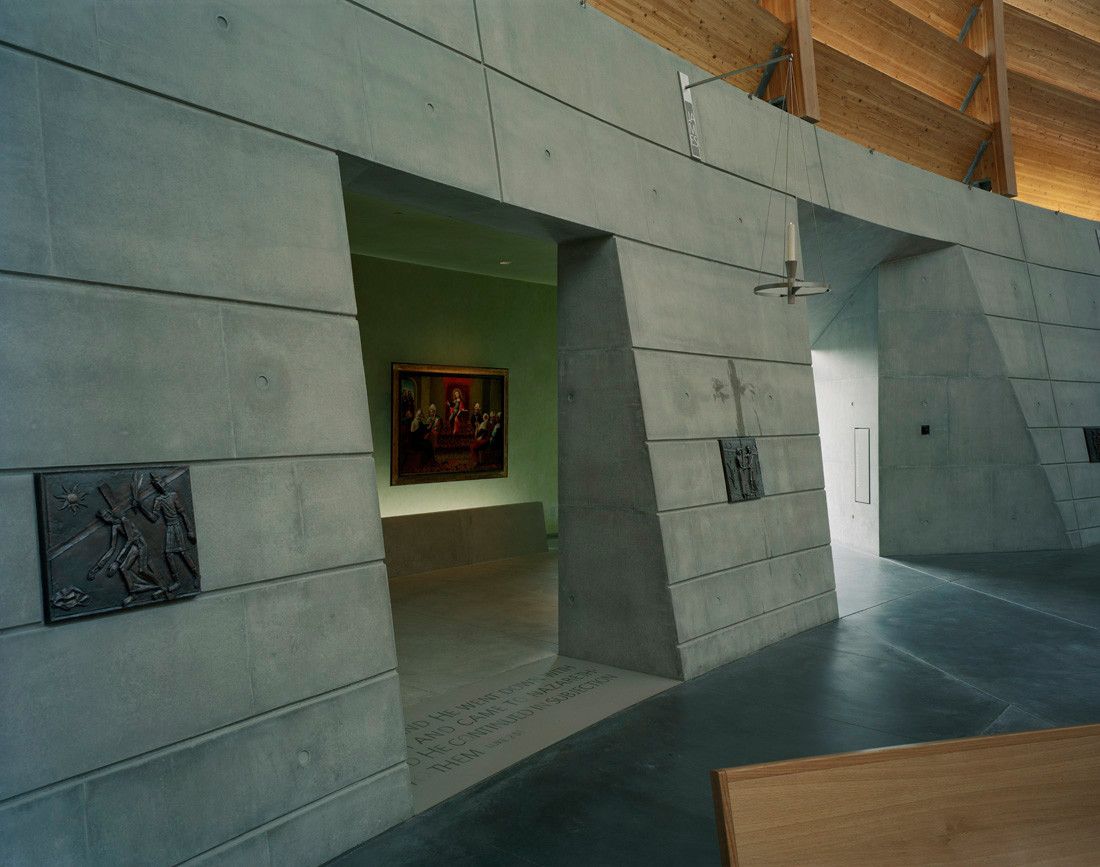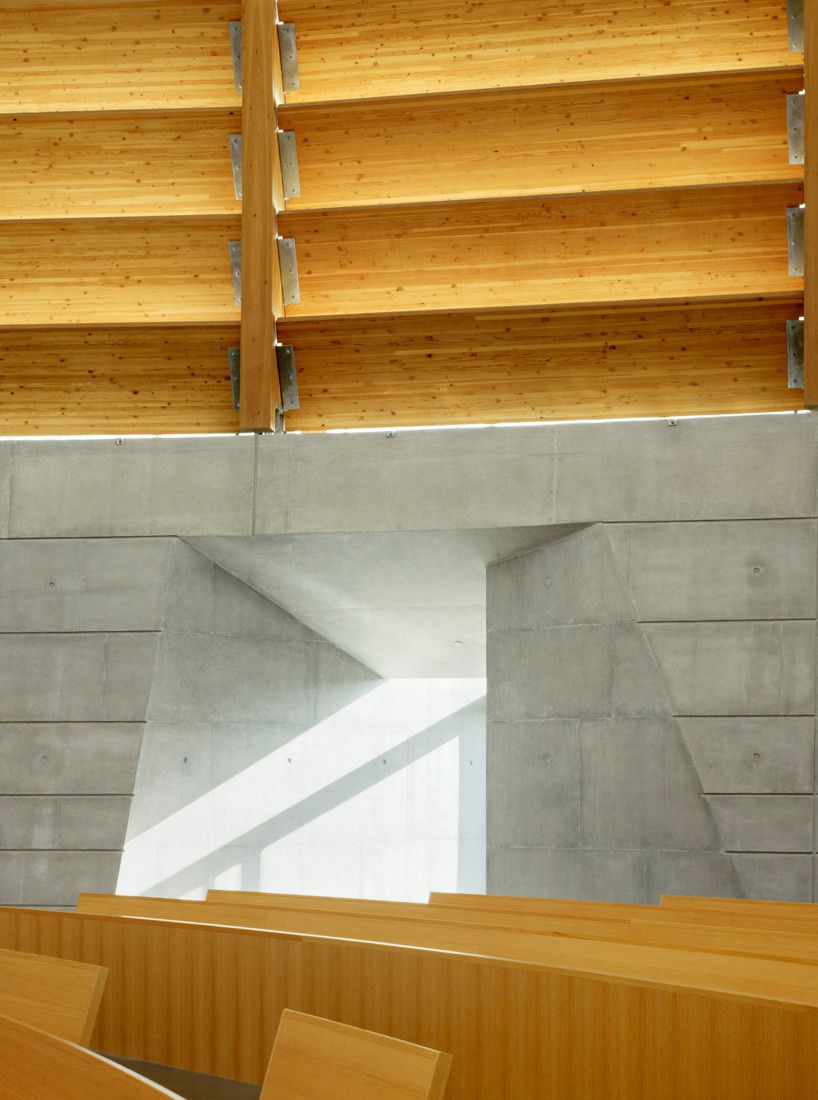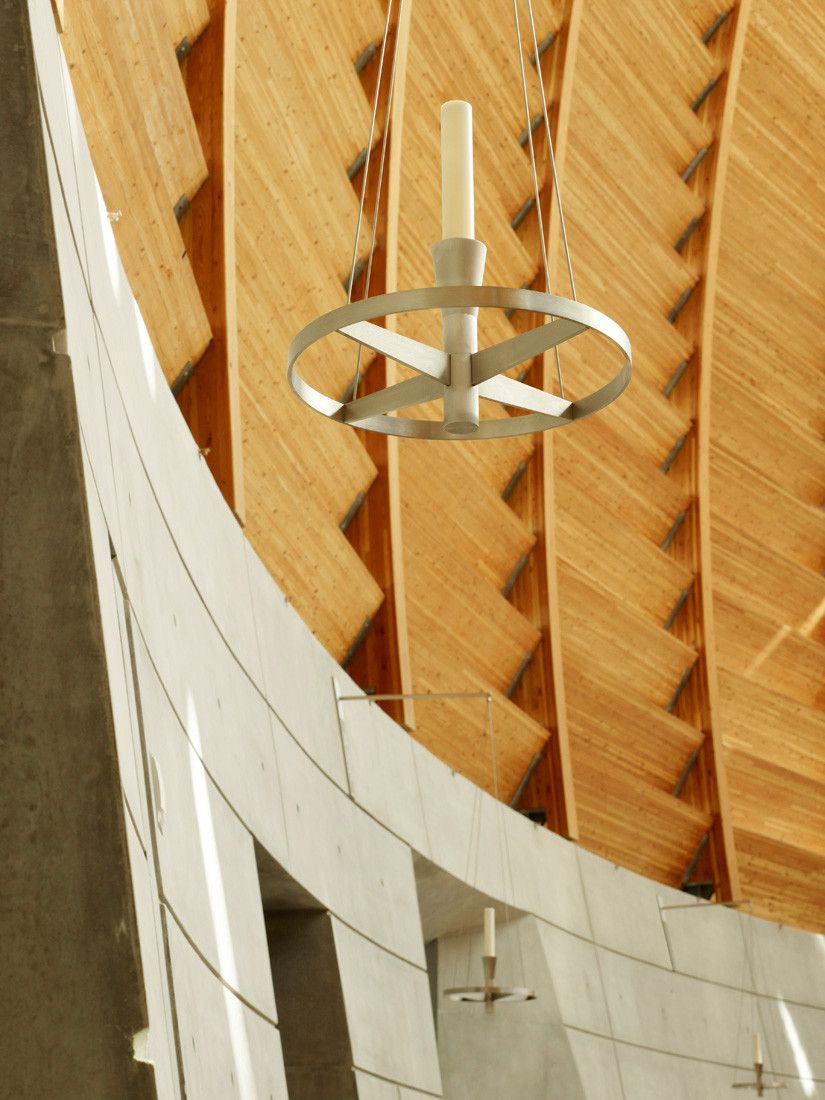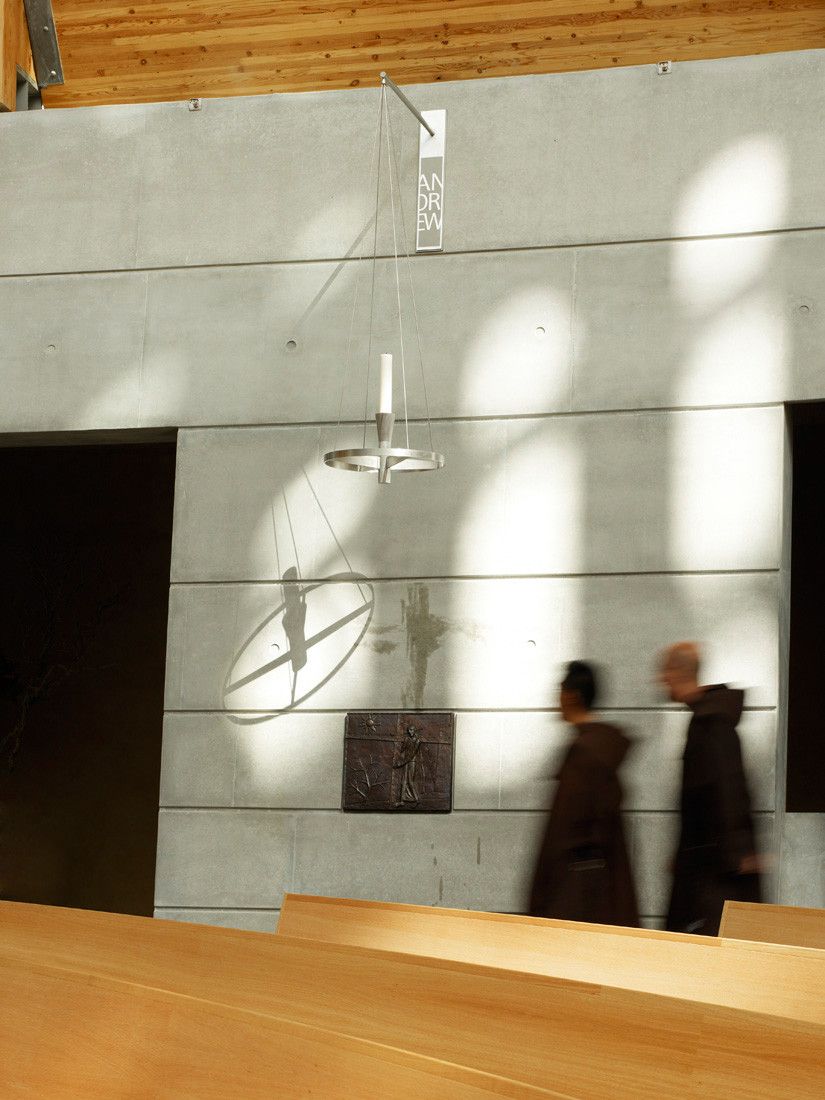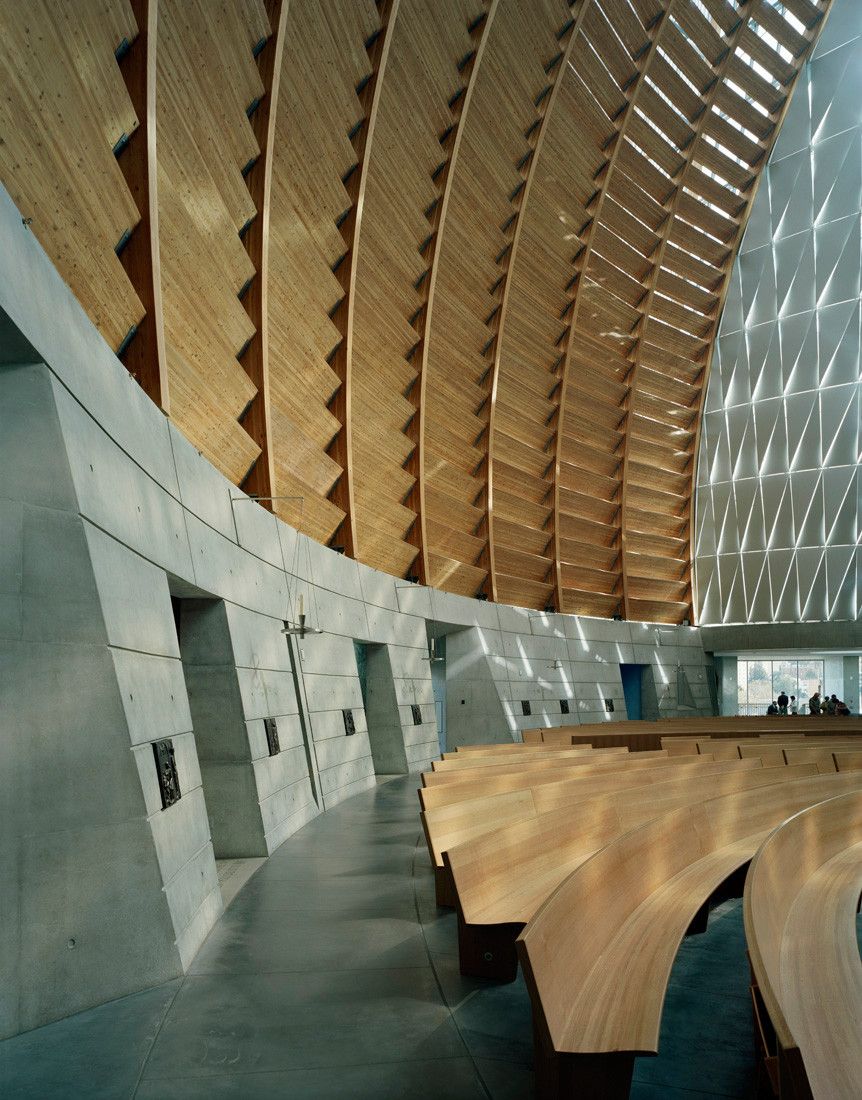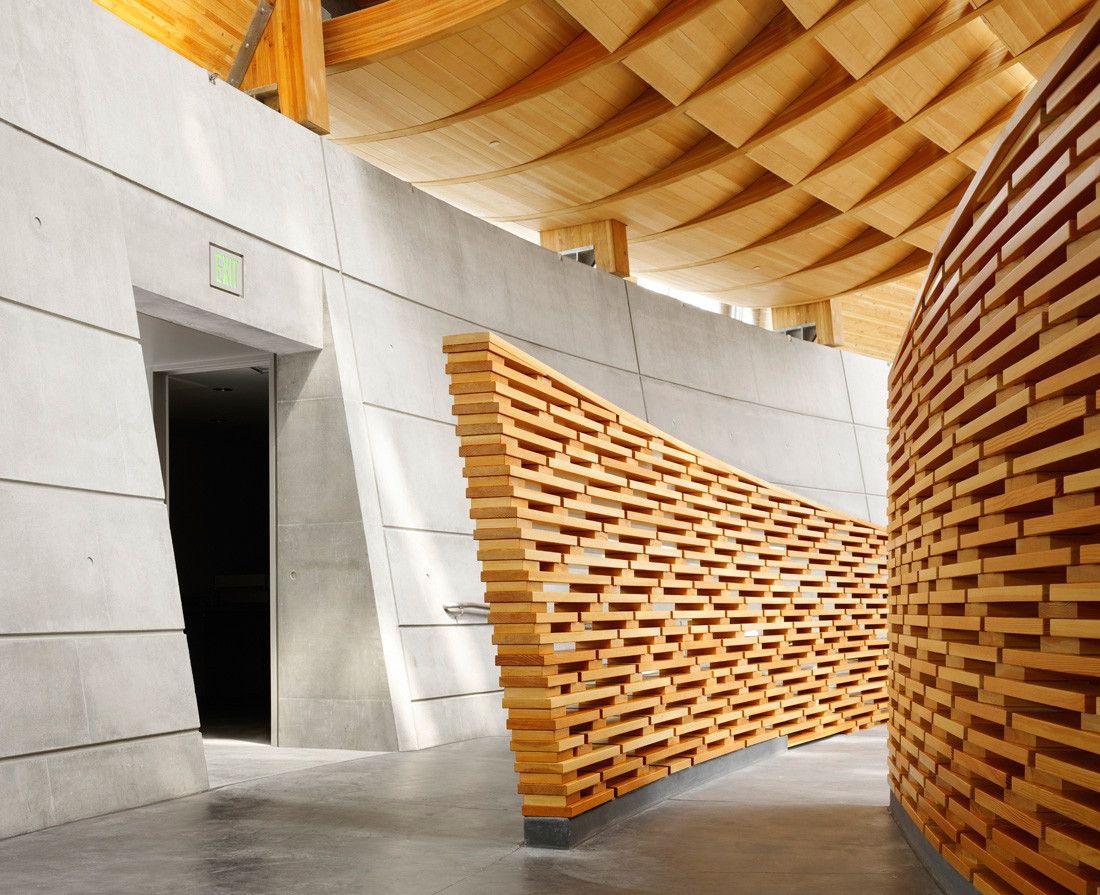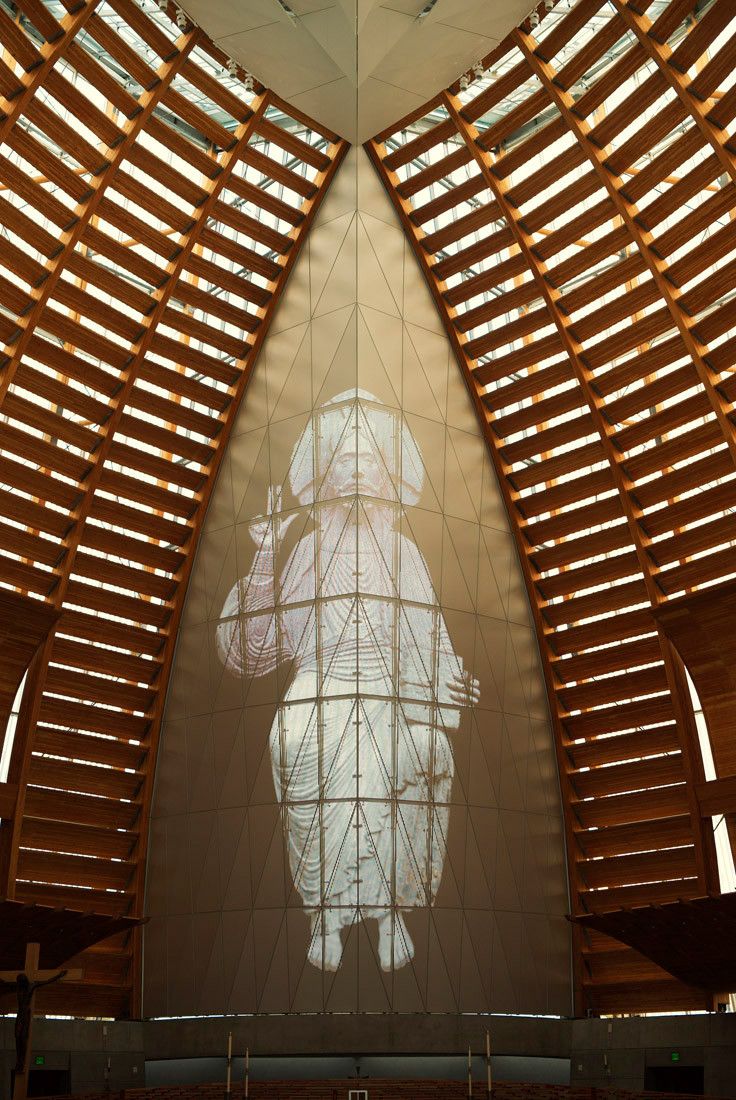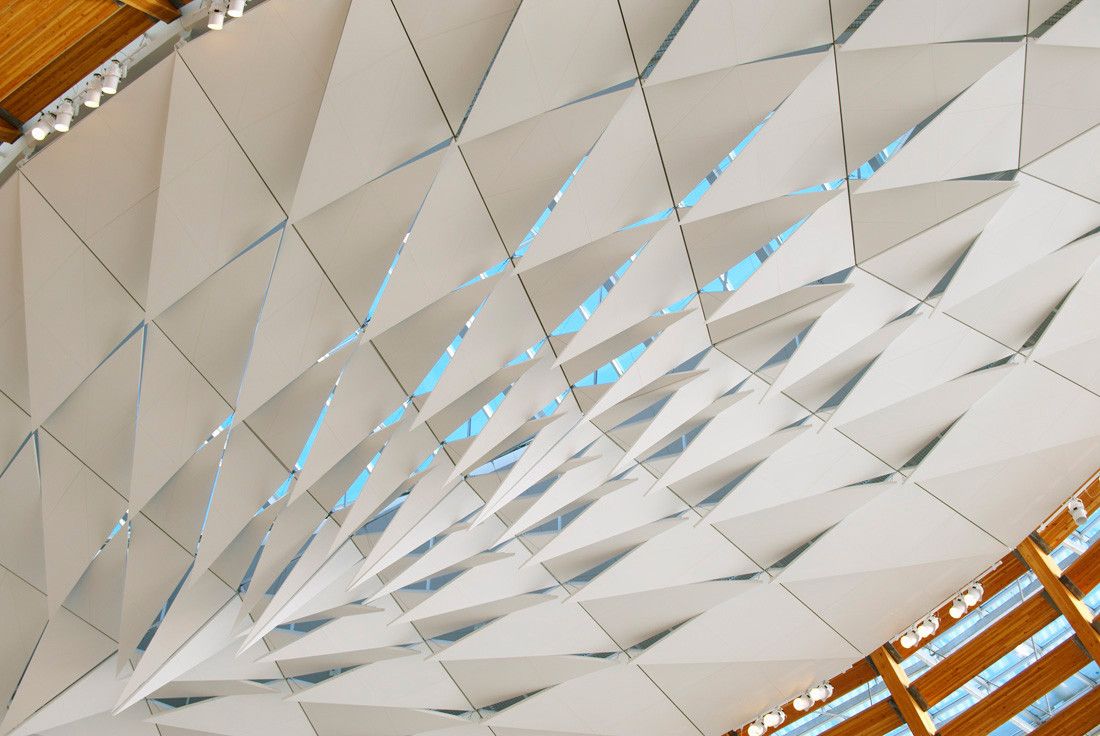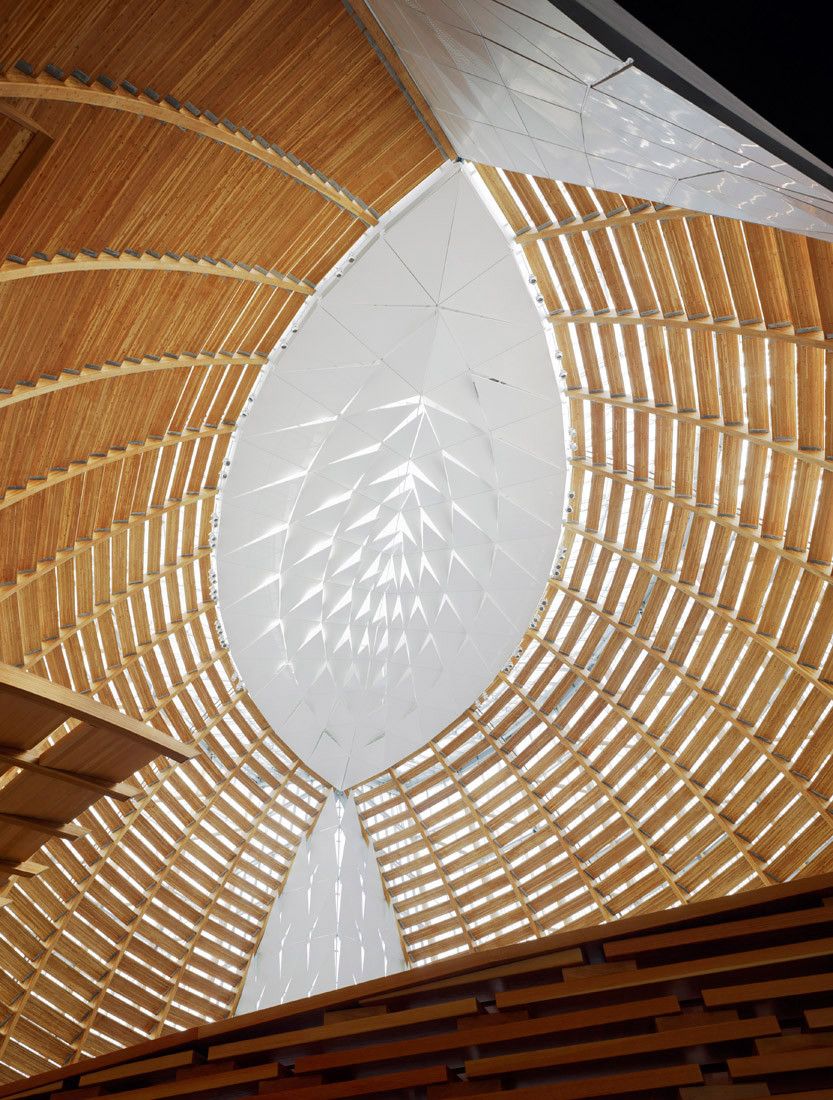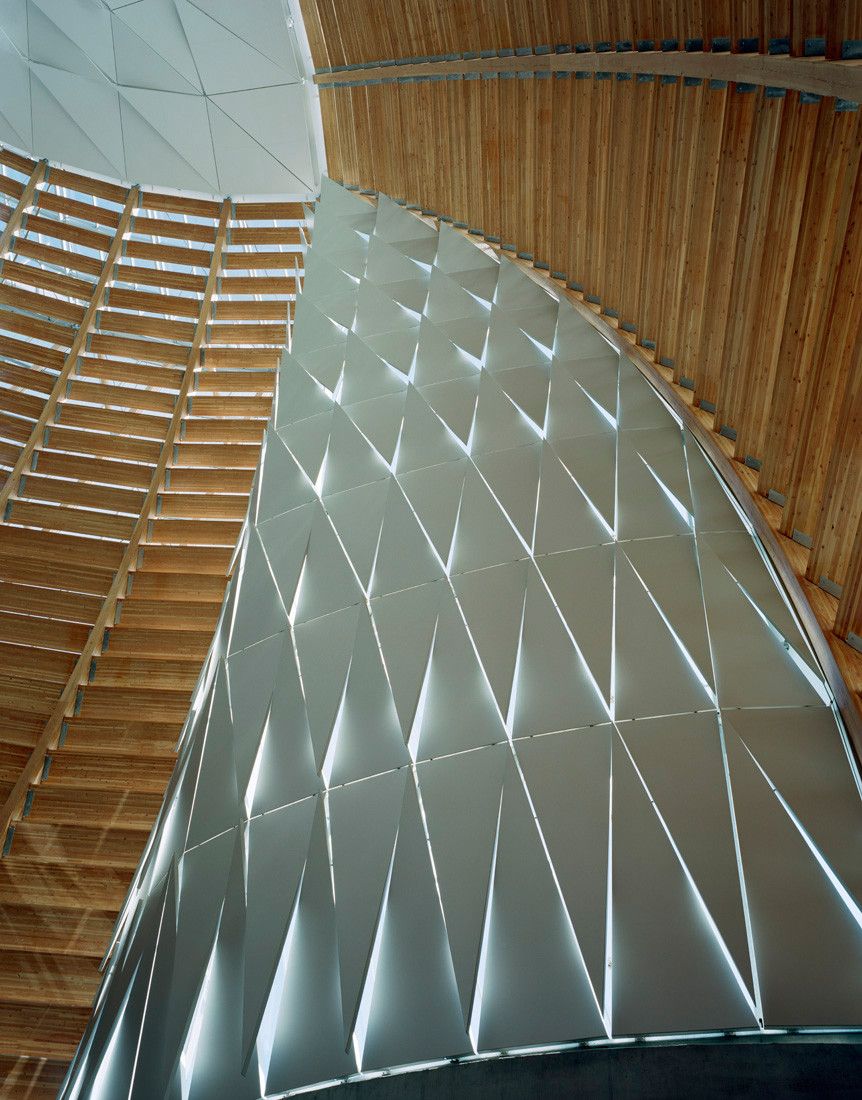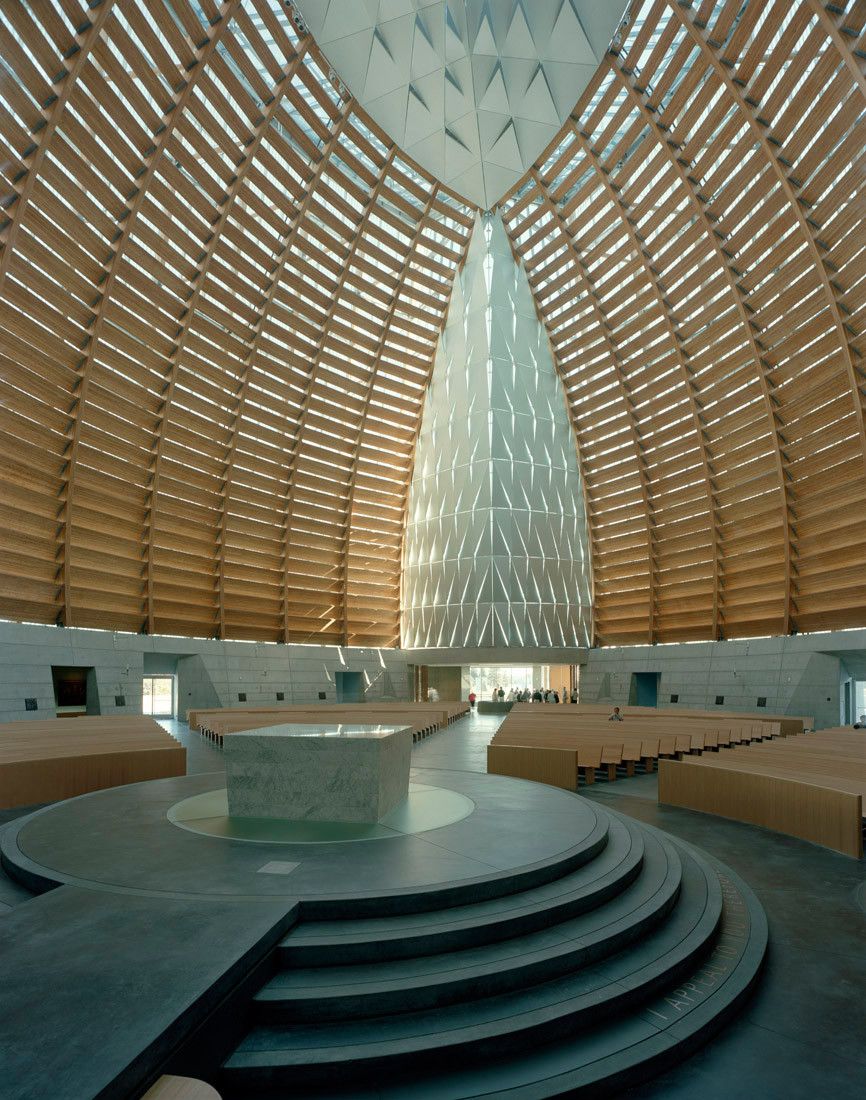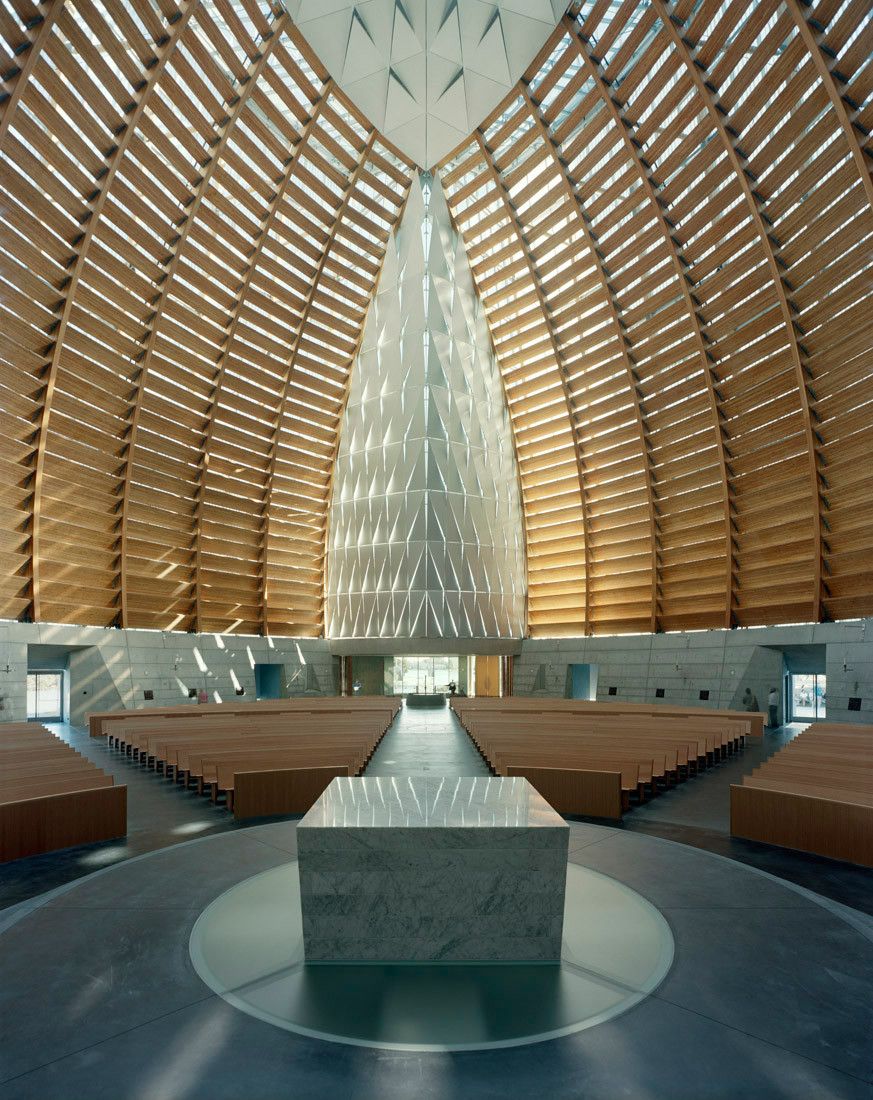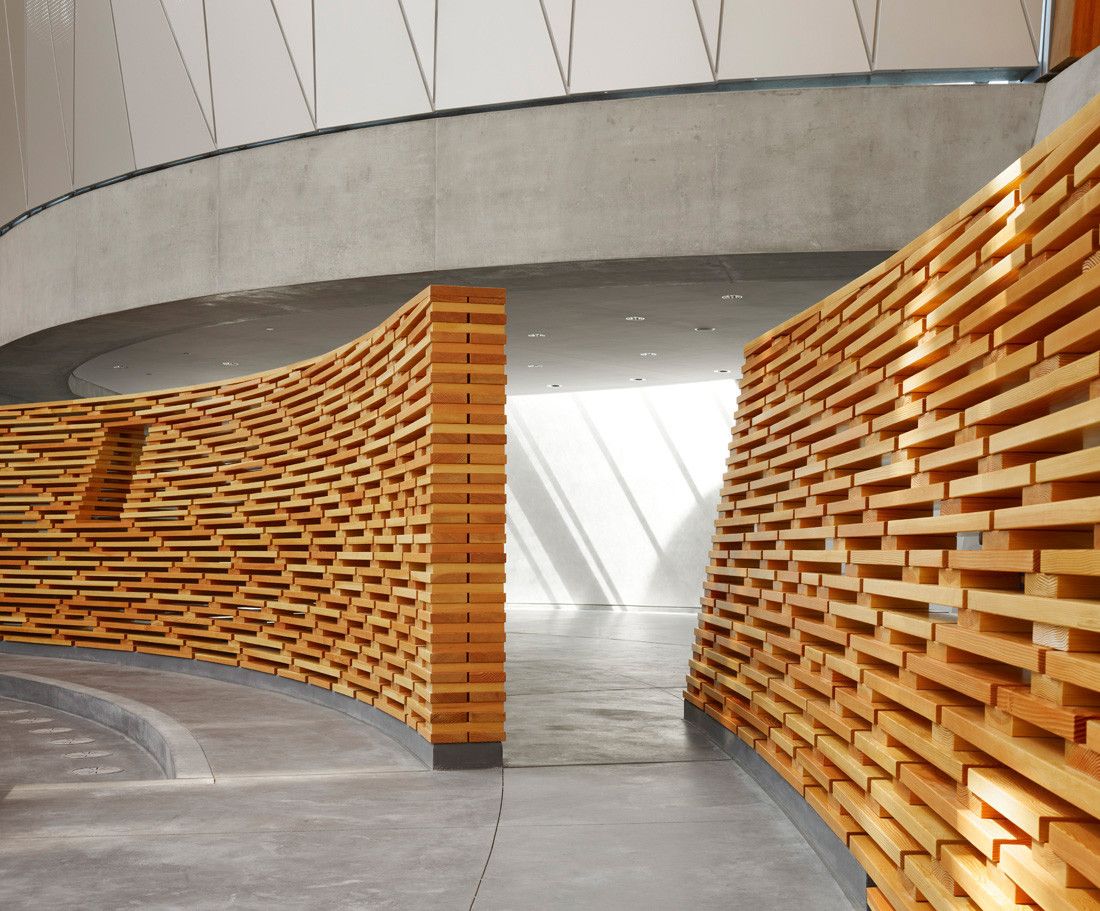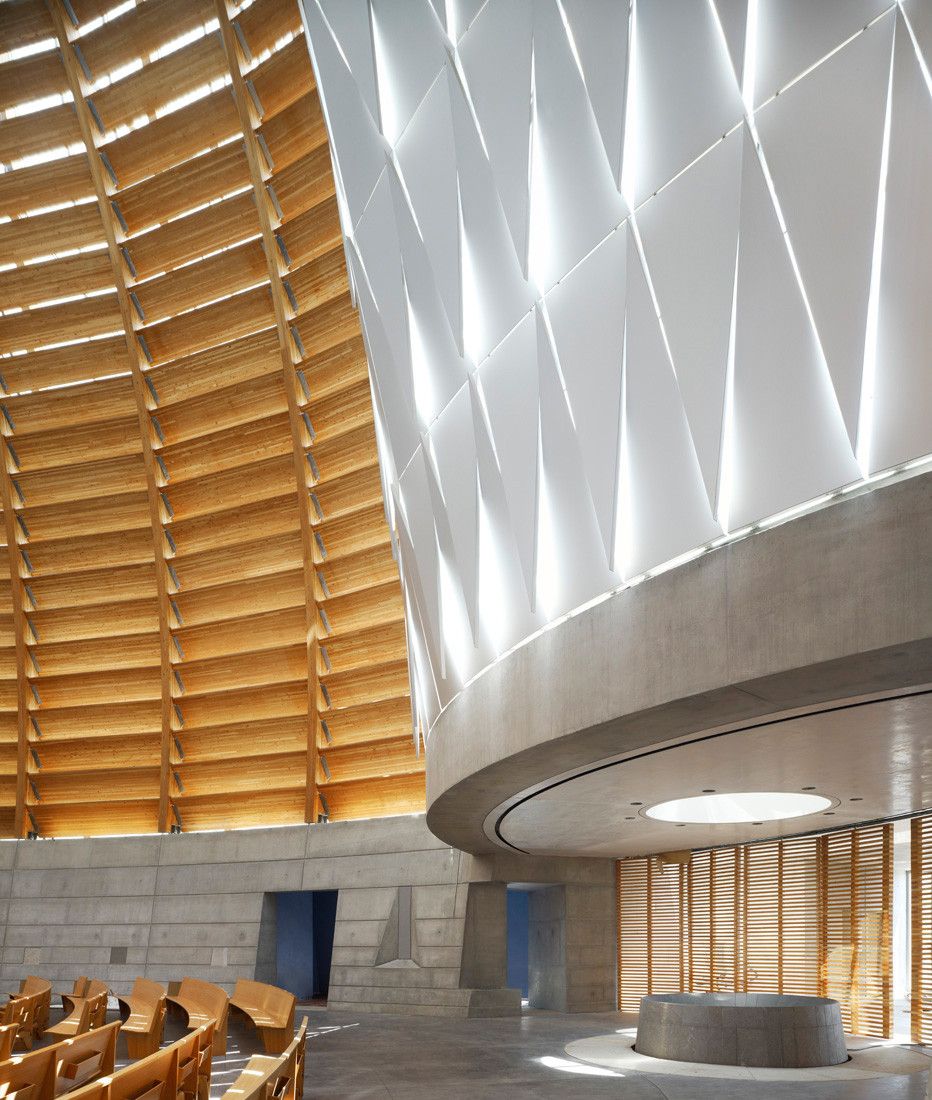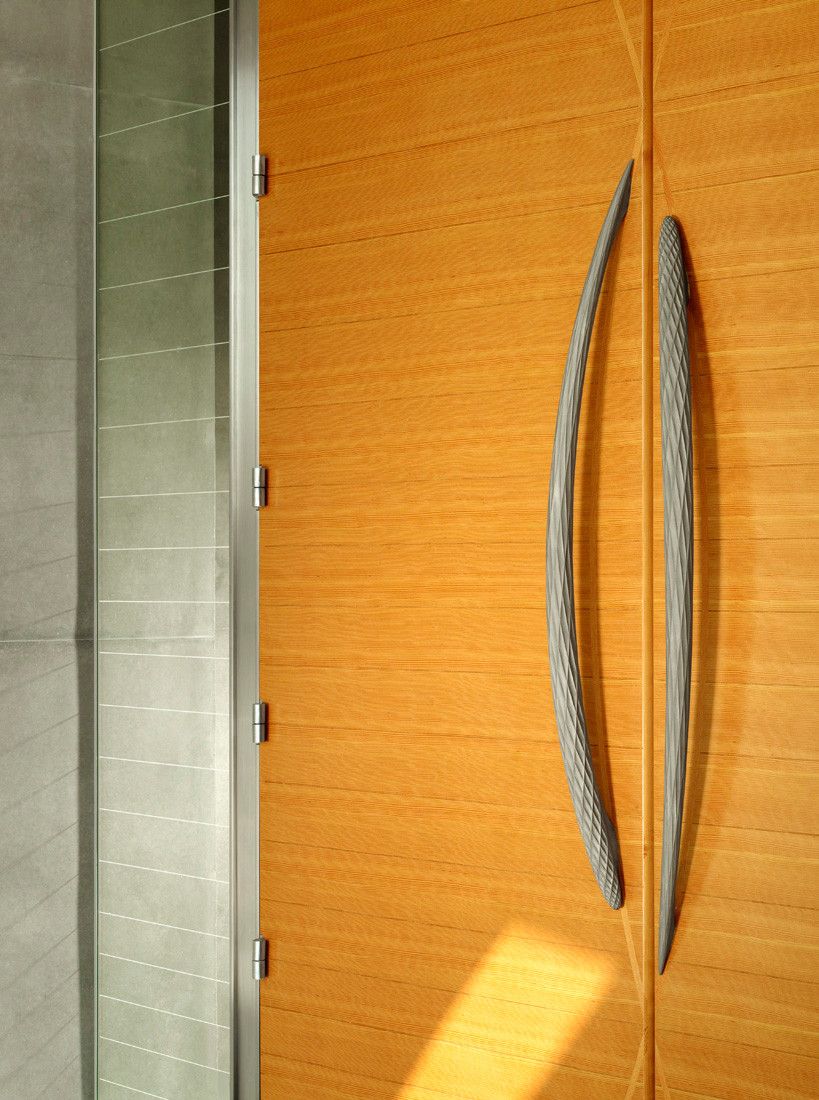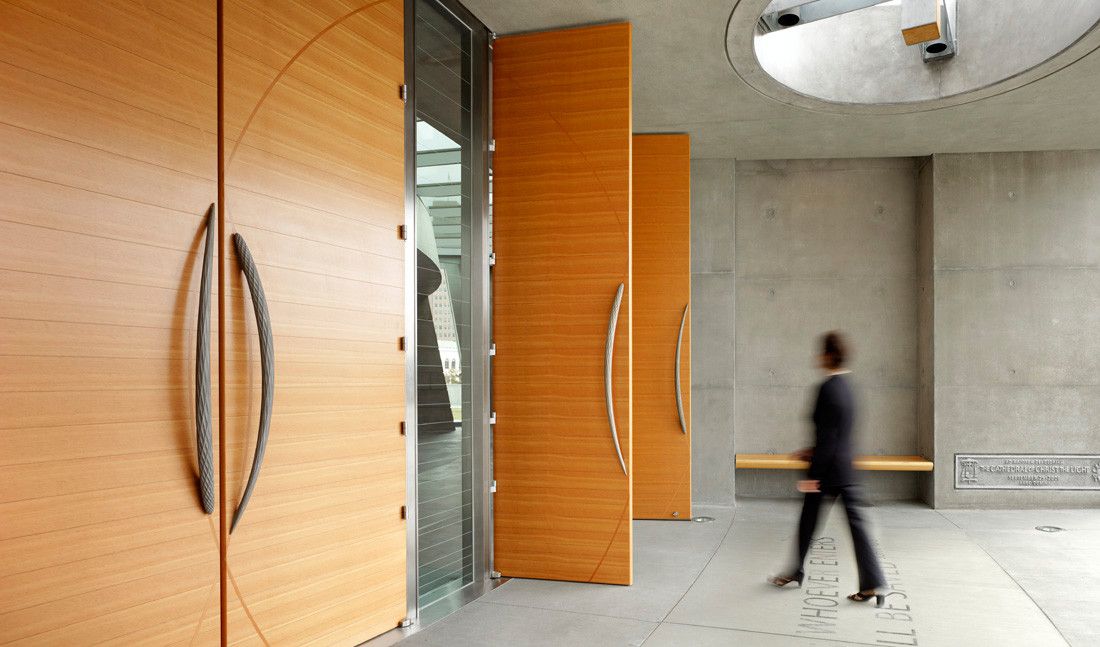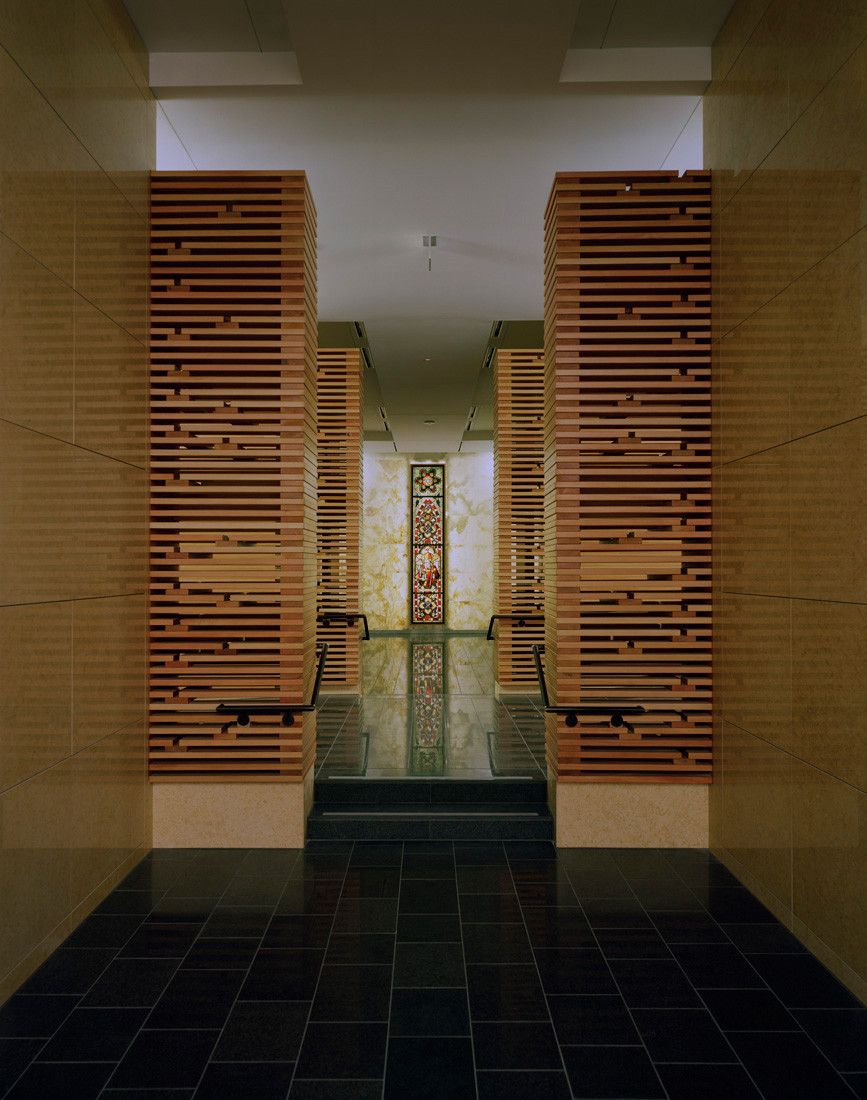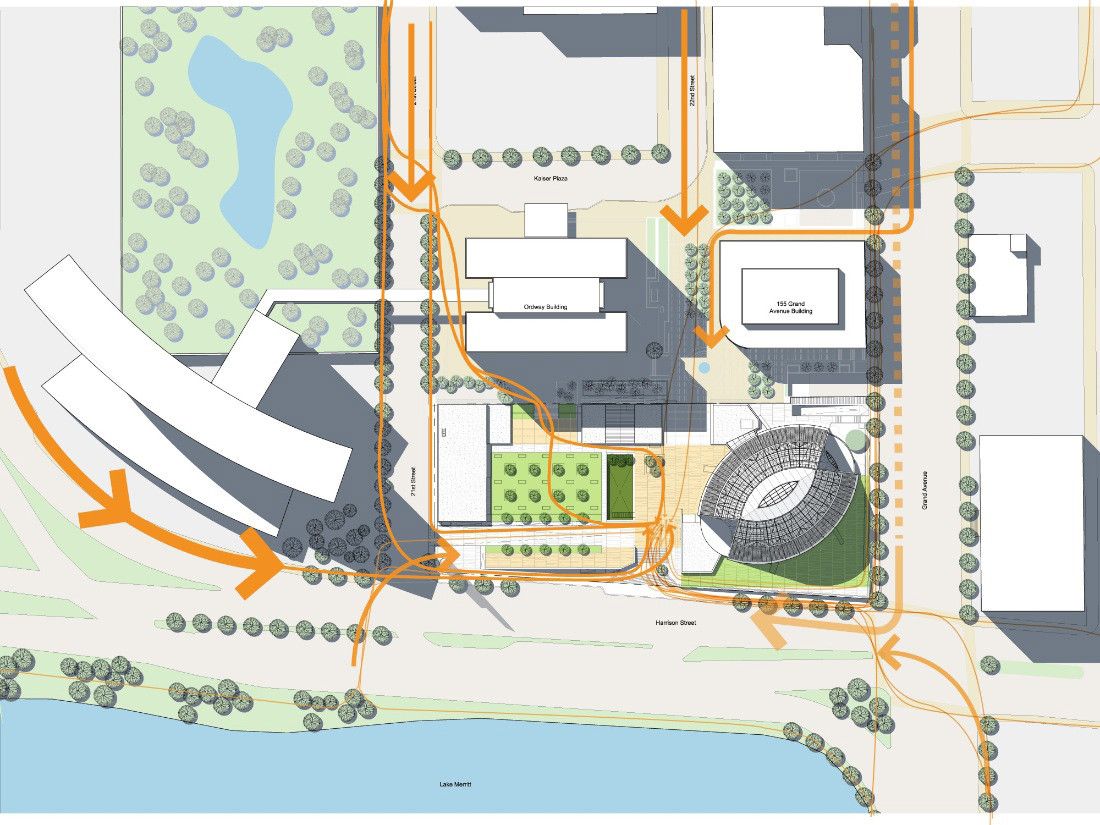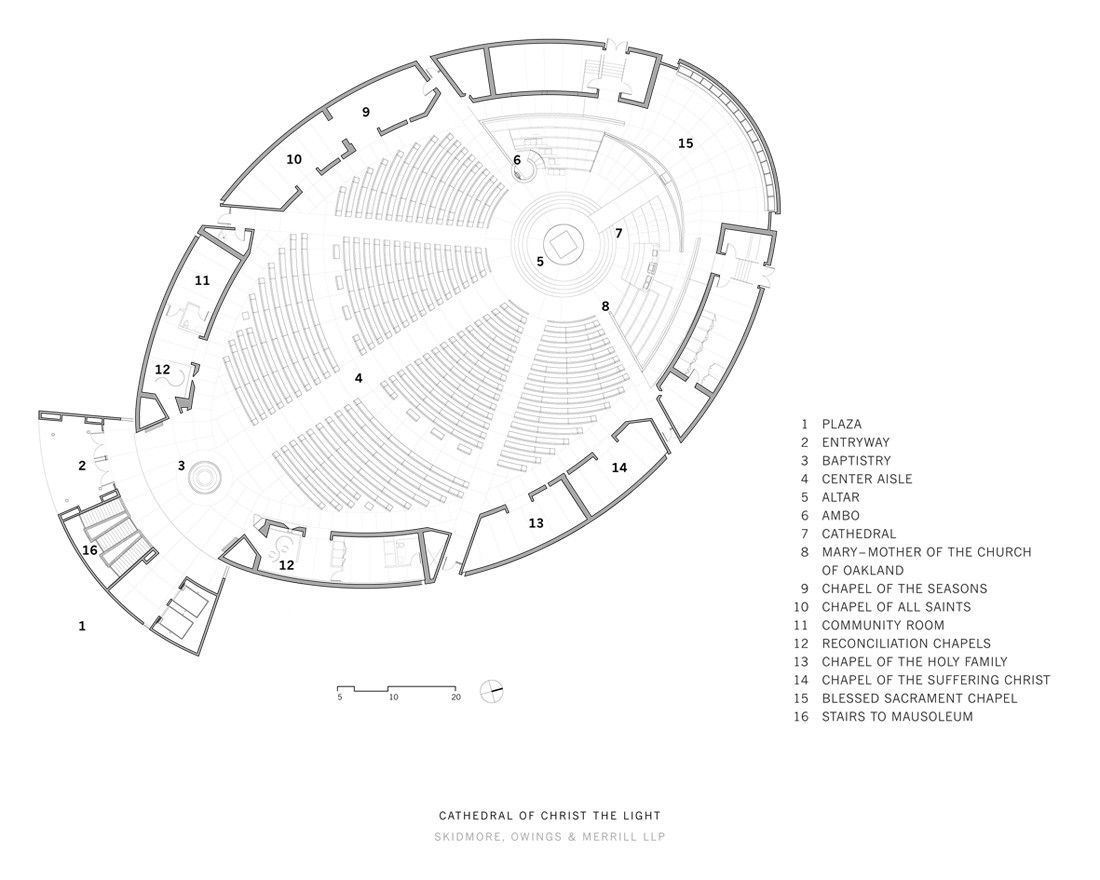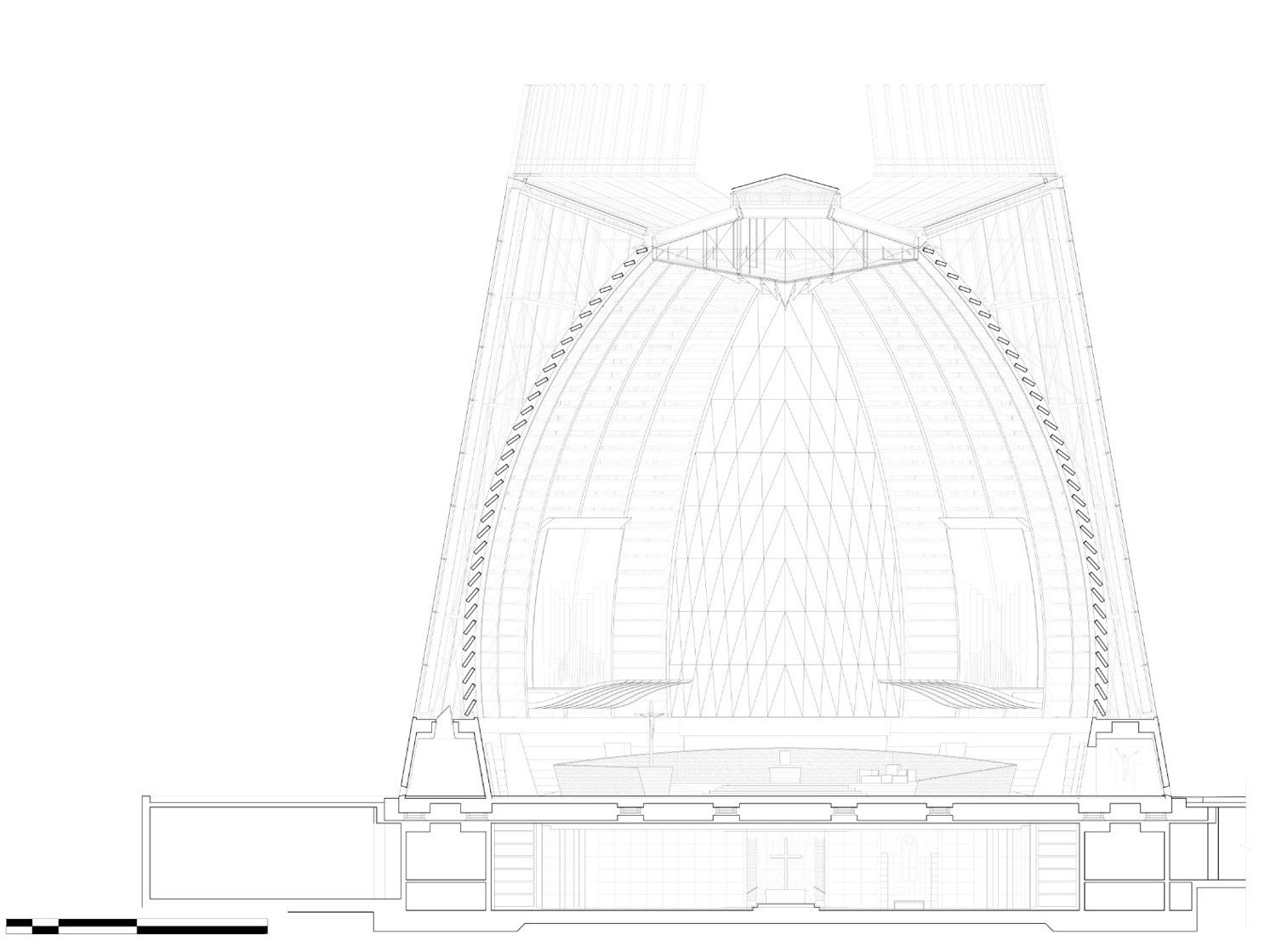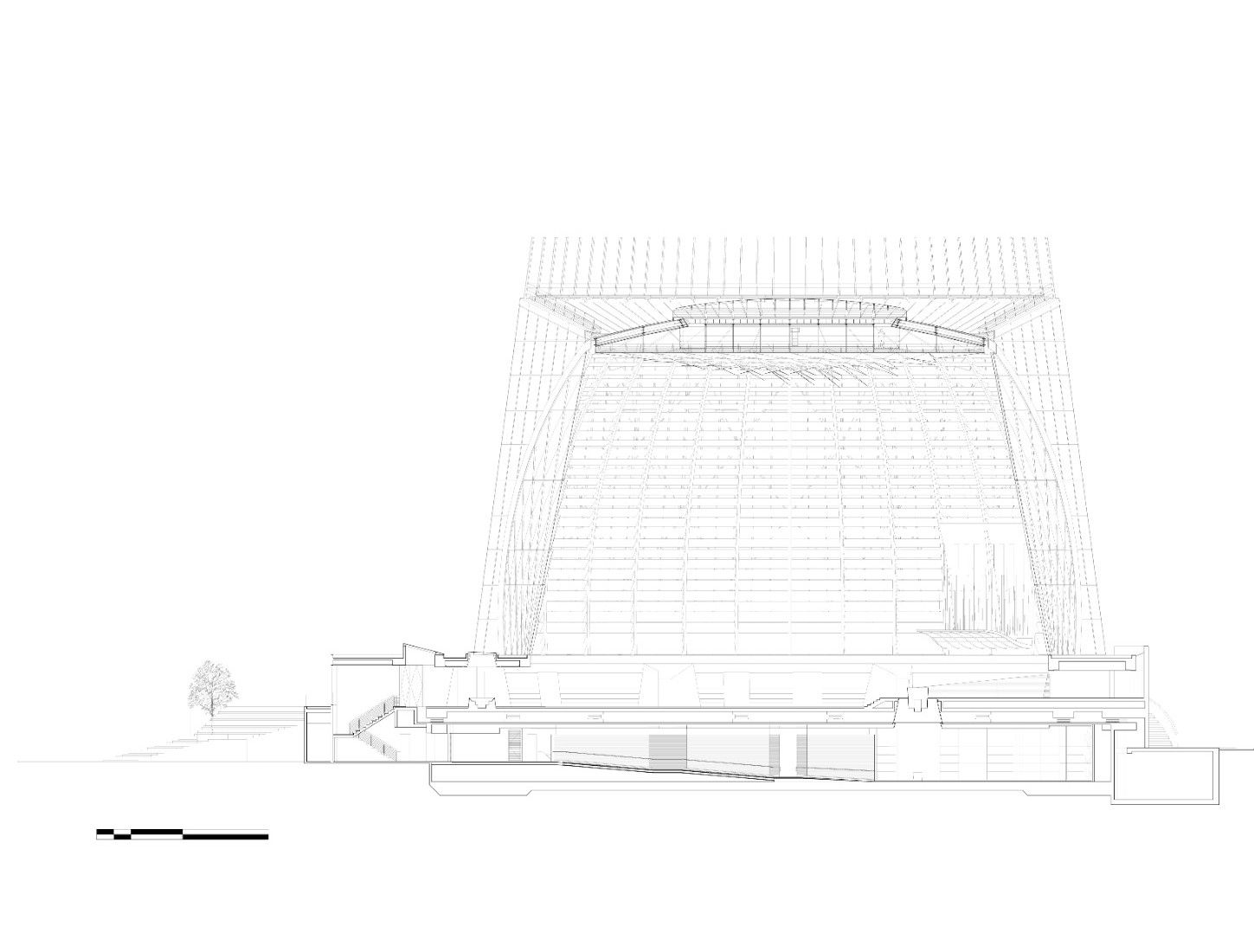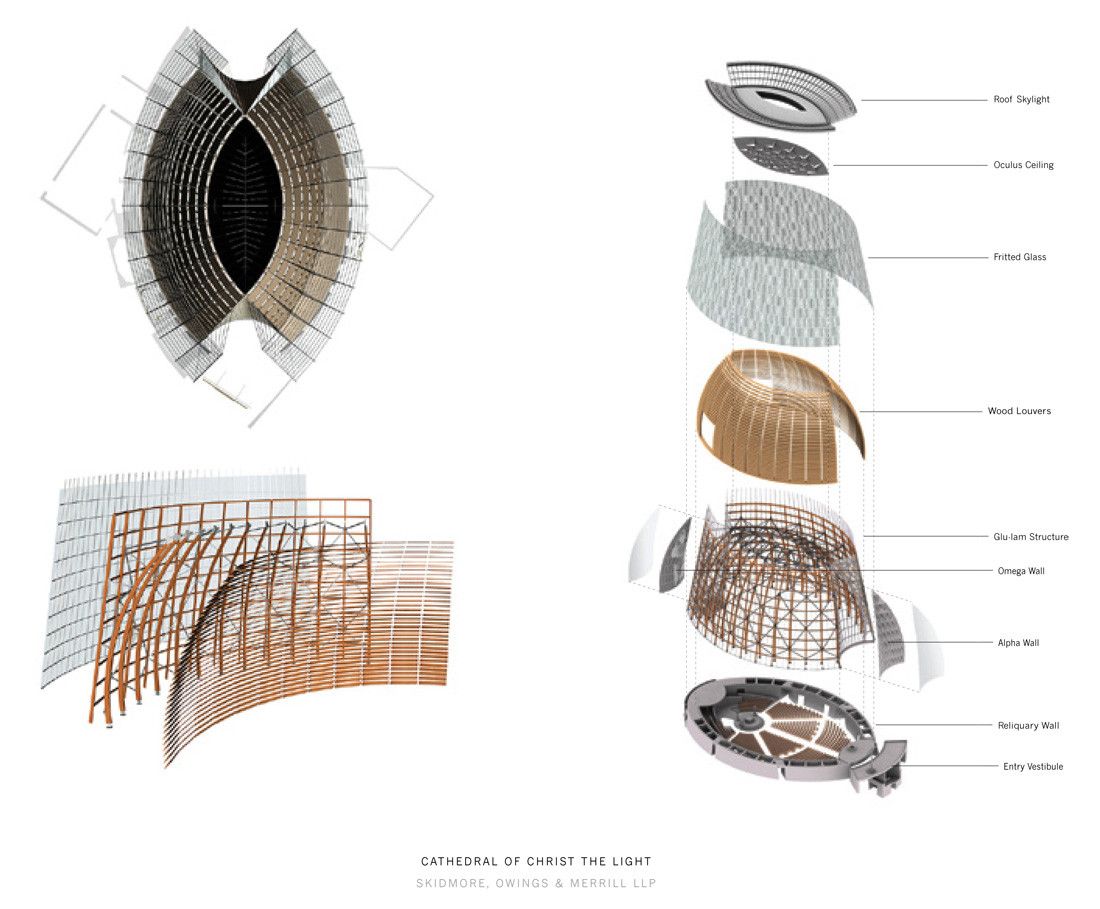The Cathedral of Christ the Light adorns the skyline of downtown Oakland with its numinous beauty and stands as an excellent example of engineering by Skidmore, Owings & Merrill (SOM). The Oakland cathedral creates a sense of consolation for the 530,000 local Catholics and reverberates as a place of worship. After the devastating Loma Prieta earthquake in 1989, the previously existing Cathedral of Saint Francis DeSales got severely damaged and the importance of a new design emerged instead of preserving the wreckage. The new design successfully ushered a new era of Cathedral Architecture while preserving the 2000 years old history without forcing a specific point of view. Craig Hartman, the lead architect for this project says, “Couldn’t imagine a more important commission than to design a Cathedral“.
Read more:
 The ‘Cathedral of Christ the Light’ building extrudes from a plan influenced by the sacred geometry of Vesica Piscis, the Latin words for ‘Fish bladder’. It involves the intersection of two circles of the same radius which was conceptually developed from the miracles of fishes and loaves in the Christian tradition. The central altar is surrounded by 1350 seats in a conical form where the outer wall of fritted glass veils it gently and truncates towards the apex, inviting the heavenly lights inside. Douglas Fir obtained a sustainable harvesting through the use of curved beams for the inner wooden skeleton. The economically sound, glued-laminated structural timber surfaces add warmth to the divine interior and strengthen the ductile elastic properties to allow bending and to revive during the maximum scale of seismic activities.
The ‘Cathedral of Christ the Light’ building extrudes from a plan influenced by the sacred geometry of Vesica Piscis, the Latin words for ‘Fish bladder’. It involves the intersection of two circles of the same radius which was conceptually developed from the miracles of fishes and loaves in the Christian tradition. The central altar is surrounded by 1350 seats in a conical form where the outer wall of fritted glass veils it gently and truncates towards the apex, inviting the heavenly lights inside. Douglas Fir obtained a sustainable harvesting through the use of curved beams for the inner wooden skeleton. The economically sound, glued-laminated structural timber surfaces add warmth to the divine interior and strengthen the ductile elastic properties to allow bending and to revive during the maximum scale of seismic activities.
 The 136 feet high curtain wall gleams like scales of fish while permitting ample light during daytime. The wall and the orbiting wooden vessels underneath it are anchored to an architectural concrete base which combats earthquake through a base isolation system and steel friction pendulum. Industrial fly ash and slag-byproducts of coal and steel industries – are used as co-binder materials instead of cement for the architecturally exposed concrete, as they require less energy for production. The involvement of ‘State of Art’ technology resulted in a space of extraordinary lightness, composed of high strength steel tension rods paired with structural wood, aluminum and glass.
The 136 feet high curtain wall gleams like scales of fish while permitting ample light during daytime. The wall and the orbiting wooden vessels underneath it are anchored to an architectural concrete base which combats earthquake through a base isolation system and steel friction pendulum. Industrial fly ash and slag-byproducts of coal and steel industries – are used as co-binder materials instead of cement for the architecturally exposed concrete, as they require less energy for production. The involvement of ‘State of Art’ technology resulted in a space of extraordinary lightness, composed of high strength steel tension rods paired with structural wood, aluminum and glass.
The interior of the Cathedral of Christ the Light
Integration of light, Catholic symbols, and contemporary aesthetic sensibilities orchestrate the interior of the Cathedral of Christ the Light. Woven wood members illustrate the confession screens and paws. The 12 apostles of Jesus Christ have been brought into, being once again through the customized consecration candle holders with a graphical representation of their names. Stainless steel letters and verses are embedded on the floor plane. The walls are anointed with the consecration oil as the candle holders adorn them. Innovatively curved wooden door handles are graphically derived from the sacred geometric circles which contain a textural topographic map of the Fibonacci series on their surfaces. Triangular cut-outs of concrete walls are embellished with terracotta carvings of Bible stories.
 The Oakland cathedral entrance is marked with an Alpha window, named after the first letter of Greek alphabet series. It also represents the Genesis which gradually leads to at the end of the journey where Jesus Christ keeps shining blissfully through an omega window. Being the last letter of Greek alphabet, the omega window indicates the end of the voyage, the eternity.
The Oakland cathedral entrance is marked with an Alpha window, named after the first letter of Greek alphabet series. It also represents the Genesis which gradually leads to at the end of the journey where Jesus Christ keeps shining blissfully through an omega window. Being the last letter of Greek alphabet, the omega window indicates the end of the voyage, the eternity.
The three-dimensional representation of Jesus Christ through 58 feet high window, is based on a sculptural depiction from the 12th century on the façade of Chartres Cathedral, France and was added as per request of Bishop Vigernon. Craig Hartman, the architect in charge developed an algorithm of light and shadow to replicate the original sculpture along with his team. Hartman consulted his retired SOM partner, Walter Netsch, who designed the 1950s Cadet Chapel at the U.S. Air Force Academy, to achieve the goal of engineering the heavenly lighting. 154 triangular anodized aluminum panels with 94,000 perforations rendered the ethereal image. Screenings cover and expose the ephemeral daylight, constantly fade or reveal the clarity of the grand portrait, reflecting every beam of the passing clouds. “The design allows light to filter in, reminiscent of how light filters through a canopy of tall redwood trees in a wooded glade“, Hartman said.
 The ceiling is covered by an Oculus of 140 aluminum panels angled systematically to diffuse gentle light and create a poetic milieu. The breaks within the shafts allow small glimpses of the sky. The building’s core design objective is achieved as the design incorporates the lightest ecological footprint and minimalistic consumption of energy. Being entirely lit by daylight, the structure employs recycled materials to provide better adhesive and reduces waste. The interior climate is maintained with thermal mass densification and radiant heat – a passive cooling technique adopted by the ancient Romans where natural convection occurs as the air rises up within the floor vents and releases through the openings of oculus.
The ceiling is covered by an Oculus of 140 aluminum panels angled systematically to diffuse gentle light and create a poetic milieu. The breaks within the shafts allow small glimpses of the sky. The building’s core design objective is achieved as the design incorporates the lightest ecological footprint and minimalistic consumption of energy. Being entirely lit by daylight, the structure employs recycled materials to provide better adhesive and reduces waste. The interior climate is maintained with thermal mass densification and radiant heat – a passive cooling technique adopted by the ancient Romans where natural convection occurs as the air rises up within the floor vents and releases through the openings of oculus.
The Cathedral of Christ the Light is 250,000 square feet area built on a 2.5 acres site and consists of side chapels, baptistery, dependencies, a large mausoleum, a conference center, chancery offices, residences, bookstores and a café. A public plaza and a garden, designed by the landscape architect Peter Walker and Partners, are interlaced with the complex which links it up with downtown Oakland.
The mausoleum conveys a gentle serenity of the foundation with thin panels of Carrara marbles lit from behind. 1850 cremation niches and 1300 crypts awaiting to be the final destination amongst which 12 are reserved for the past, present and future Bishops of Oakland. Elegant use of stained glass graces the atmosphere. The 18-feet high mausoleum is a substructure of reinforced concrete which gradually extends to the concrete mat foundation.
 The architecturally scaled graphic elements sensitively avoided traditional iconography which converted the Cathedral of Christ the Light beyond a liturgical space for a significant religious community. The cultural and civic role of the project got praised by numerous architectural and social critics as well as unanimous approval from the Oakland Planning Commission.
The architecturally scaled graphic elements sensitively avoided traditional iconography which converted the Cathedral of Christ the Light beyond a liturgical space for a significant religious community. The cultural and civic role of the project got praised by numerous architectural and social critics as well as unanimous approval from the Oakland Planning Commission.
The structural efficiency won a number of awards including the Society of Experiential Graphic Design (SEGD) awards in 2009. One of the jurors wrote, “Most compelling is the innovative use of modest materials, coupled with filtered natural light and sparing use of finely carved design details. The graphic elements add a rich simplicity to this otherwise spare volume punctuated with rich light and images. Bare concrete and stainless steel accents give way to a serene volume and the balanced warmth of natural light. Nothing but serene reflection is possible here“.
 Other prestigious awards include National Honor Award for Interior Architecture by American Institute of Architects (AIA), California Wood Design Award: Landmark Category, Award of Excellence: Large Project by Structural Engineers Association of Northern California etc. Currently, the Cathedral of Christ the Light shines as an enlightened house of Jesus Christ at the banks of Lake Merritt.
Other prestigious awards include National Honor Award for Interior Architecture by American Institute of Architects (AIA), California Wood Design Award: Landmark Category, Award of Excellence: Large Project by Structural Engineers Association of Northern California etc. Currently, the Cathedral of Christ the Light shines as an enlightened house of Jesus Christ at the banks of Lake Merritt.
Project Info:
Architect: Skidmore, Owings & Merrill (SOM)
Location: Oakland, CA, USA
Project Year: 2005 – 2008
Project Architect: Craig Hartman
Landscape Architects: Peter Walker and Partners
Interior Designers: Tamara Dinsmore, ChandaCapelli, Susanne LeBlanc, Carmen Carrasco, David Lou
Civil Engineering: Korve Engineering
Electrical Engineering: The Engineering Enterprise
Mechanical Engineering: Taylor Engineering, LLC
Client: Catholic Diocese of Oakland
Project Name: Cathedral of Christ the Light.
All images courtesy of SOM.
Courtesy of SOM
Courtesy of SOM
Courtesy of SOM
Courtesy of SOM
Courtesy of SOM
Courtesy of SOM
Courtesy of SOM
Courtesy of SOM
Courtesy of SOM
Courtesy of SOM
Courtesy of SOM
Courtesy of SOM
Courtesy of SOM
Courtesy of SOM
Courtesy of SOM
Courtesy of SOM
Courtesy of SOM
Courtesy of SOM
Courtesy of SOM
Courtesy of SOM
Courtesy of SOM
Courtesy of SOM
Courtesy of SOM
Courtesy of SOM
Courtesy of SOM
Courtesy of SOM
Courtesy of SOM
Courtesy of SOM
Courtesy of SOM
Courtesy of SOM
Courtesy of SOM
Courtesy of SOM
Courtesy of SOM
Courtesy of SOM


